
















































Italy has been among the EU countries most active at establishing Fisheries Local Action Groups (FLAGs). ese organisations o er a bottom-up approach to improving the prospects and the economies in communities where sheries and/or aquaculture play a signi cant role. A form of community led local development, FLAGs bring together municipalities, local companies, and civil society organisations such as NGOs and associations. With support from the EU, FLAGs design projects that contribute to improving the economy or the sustainability of activities carried out in the community. In the Friuli-Venezia Giulia region, a coastal FLAG encompassing three municipalities has implemented projects to make the towns more attractive for tourists, to reduce the dependence of shers on big seafood buyers, and to diversify the income of small-scale shers, among others. e coverage of Italy includes information on a tool that for the rst time enables Mediterranean producers of seabass and seabream to benchmark the performance of their farms against the industry average. is should allow individual farmers to set targets and monitor performance potentially creating a more e cient and sustainable industry. Read more from page 22
Seafood Expo Global (SEG) and Seafood Processing Global (SPG) together form the biggest and most international event for the global seafood industry. e event this year, the 29th, promises to be the biggest ever with almost 50,000 m2 (up 23 compared to 2022) and 66 national and regional pavilions. Space at SPG increases some 20 and will be occupied by suppliers of a wide range of processing and packaging equipment, as well as technology solutions for the seafood industry that will help seafood processors optimise their operations, improve e ciency, and enhance the quality of their products—all critically important at this time of shortages and high costs. Both events provide an excellent opportunity for seafood industry professionals to network, exchange ideas, and learn about the latest trends and innovations in the industry. ey are also a platform to promote sustainable seafood practices and to highlight the importance of responsible shing and aquaculture. Read about selected Euro sh member country’s participation at these events from page 15
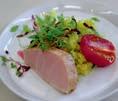
e use of algae in feeds for juvenile sh is an emerging trend in the aquaculture industry. Algae are a sustainable and nutrientrich feed source that can provide many bene ts to both sh and the environment. Algae contain omega-3 fatty acids, protein, and other essential nutrients that are critical for the growth and development of juvenile sh. One of the main advantages of using algae in sh feed is their sustainability. Algae can be grown using a fraction of the resources required for traditional animal-based feeds, such as shmeal and sh oil. Additionally, the use of algae in sh feed can reduce the reliance on wild-caught sh, which can help to conserve marine resources. Another bene t of algae-based sh feed is their potential to improve sh health and performance. Algae contain bioactive compounds that can boost the immune system of juvenile sh and reduce the incidence of disease. Moreover, the use of algae in sh feed can improve the taste and nutritional value of farmed sh, which can lead to higher market value. However, there are also challenges to using algae in sh feed, such as the high cost of production and the need to develop cost-e ective and scalable cultivation methods. ere is also a need to ensure that algae-based feeds are nutritionally balanced and meet the speci c dietary requirements of juvenile sh. Read more on page 43

Ghost shing by derelict nets is a signi cant environmental problem that a ects marine ecosystems around the world. Derelict nets are shing nets that have been lost or abandoned in the ocean and continue to trap and kill marine animals long after they have been discarded. ese nets can remain in the ocean for decades, continually trapping and killing sh, sea turtles, whales, dolphins, and other marine life. Ghost shing can have devastating e ects on marine ecosystems. When sh and other marine animals become trapped in the nets, they die from su ocation, starvation, or exhaustion. e trapped animals also attract scavengers, which can become entangled in the nets themselves, creating a vicious cycle of death and destruction. Moreover, since nets today are often made of plastic, as they slowly breakdown they add to the macro, micro, and nanoplastic pollution in the water. e problem of ghost shing by derelict nets is not only an environmental issue, but it also has economic consequences. Lost and abandoned nets can continue to catch sh, reducing sh stocks and a ecting the livelihoods of shermen and shing communities. Many countries have introduced regulations to reduce the problem of abandoned or lost nets, but Norway has managed better than most in terms both of regulations and of creating the necessary infrastructure. Read more on page 49
Fraud in the seafood sector is a signi cant problem that a ects the entire supply chain, from shermen to retailers and consumers. is practice involves labelling one type of sh as another, either to deceive consumers or to take advantage of the higher value of a particular species. One of the main reasons for this misidenti cation is the high demand for certain species of sh and the limited supply. Some shermen may mislabel other, more abundant species to fetch a higher price. e consequences of deliberate misidenti cation are signi cant. Consumers may be misled into buying sh that they did not intend to purchase, which can be a health risk if the product has a higher risk of contamination or of triggering allergic reactions. Moreover, the misidenti cation of sh can have a severe impact on the sustainability of sheries and marine ecosystems. E orts to address the issue of fraud include stricter regulations and monitoring of the seafood supply chain, DNA testing, and labelling requirements. Consumers can also play a role by becoming more educated about sustainable seafood practices and making informed purchasing decisions. Read Dr Manfred Klinkhardt’s article on page 54


15 Seafood Expo Global/Seafood Processing Global, 25-27 April 2023, Barcelona
The world’s largest seafood event becomes even bigger
16 Croatia: 2E701
A range of marine and freshwater products
16 Poland: 4G401 and other halls












Exploring the best of Polish seafood at Seafood Expo Global
18 Denmark: 3CC201, 3DD201, 3EE201, 3EE401, 3FF401, 3PP202 Danish companies present sustainable solutions at Seafood Processing Global 2023
19 Latvia: GA301
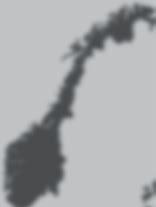


Takes two to tango – very traditional and very new products on the same dance floor
20 RASTech 2023, 20-22 April, Orlando, Florida USA
A deep dive into the RAS industry
22 AquaFarm, NovelFarm, AlgaeFarm 2023, 15-16 February 2023, Pordenone
Event attracts record number of exhibitors and visitors
24 Finding ways to reduce the environmental impact of fish farming Research to make aquaculture more sustainable
26 Start-up determined to sever the link between aquaculture and marine resources
Optimising insect meal for faster fish growth
28 A new tool to boost marine aquaculture in the Mediterranean Project improves European seabass and seabream farming
32 A producer organisation supplying seabass, seabream, and meagre to local supermarkets
Del Pesce works towards greater sustainability
34 Reducing plastic pollution in the Mediterranean Sea. Reusable fish boxes suggest a way forward
36 The Friuli-Venezia Giulia FLAG helps its members diversify their incomes


Investing in a variety of projects
39 Remotely Operated Vehicles (ROVs) for the aquaculture and other offshore industries
Improving technology gives greater versatility


41 The Mediterranean is threatened by non-indigenous species and by global warming
Engaging local communities in tracking biodiversity changes
43 Microalgae are gaining in importance for aquaculture Key factor for marine fish fry stocking
47 Fish and seafood from Norway 2022 was the best year in history for exports
49 Norway has a long history of policies to reduce the loss of nets at sea
Ghost nets are a multidimensional threat




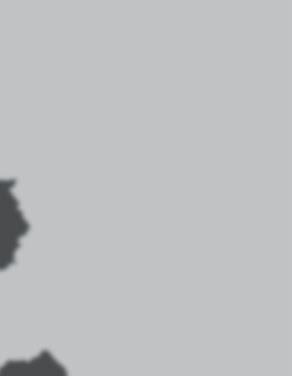

52 Polish film project teaches schoolchildren about the multifaceted Baltic Sea A series that educates and entertains
53 Eurofish participation in projects Boosting consumer trust in seafood

54 Every third fish worldwide is declared incorrectly Trust is good, checks are better



58 Alltech and Finnforel join forces for sustainable aquaculture feed production
Fully integrated production offers a model to others
59 Cretel caters to the needs of the demanding food, pharma, and agroindustries
Innovative processing and washing equipment
60 Professional glass jar from FIAP for incubation of fish eggs
Better conditions than in the wild
60 Thermal processing of lying products with the REICH AIRMASTER® UKQ AIRJET
Maximum benefits require the best airflow technology
61 Innovative new films deliver greater sustainability too Improved appearance, taste, and shelf life
GuestPages:AngeloMaggiore,EFSA


62 EFSA’s work contributes to keeping consumers in the EU healthy Food safety faces added risks from climate change

The Danish Fisheries Agency has announced that it will enforce, and sanction violators of a new rule governing brown crab fishing in the North Sea. In the technical regulation (Regulation no. 2019/1241 of the European Parliament and of the Council, Annex V, Part A) it is established that: “For brown crab caught in nets and baskets, no more than 1 percent by weight of the total catch of brown crab may consist of removed claws. For brown crab caught with other gear, a maximum of 75 kg of removed crab claws may be landed.” Previously, this restriction did not exist. A transition or grace period will extend to 30 April 2023, and the regulation becomes fully effective and will be enforced from 1 May 2023.
Crab claws are the principal marketable product from brown crabs, and claws can be removed prior to the vessel’s landing or the whole animal can be landed intact. Representatives of the Danish Fisheries Agency measure the catch, including adjusting for the claw-weight equivalent of whole crabs landed, at the landing port. Industry members have expressed concern about the economic cost of this restriction, because for some boats crabs are a vital species. The Danish Fisheries Agency has expressed appreciation of this economic dependence but notes that the agency must enforce EU fishery management rules in Danish waters.
Before Brexit, the largest brown crab catch volumes belonged to the UK with average annual volumes of 31,000 tonnes, or over 60% of the total brown crab catches in the EU. Denmark’s crab fishery is rather limited, compared to other EU countries, with annual volumes fluctuating between 200 and 300 tonnes.

A brand-new industry trade show takes place 10-12 October 2023 in Amsterdam, as RAI Amsterdam and Norway’s Aqkva join forces to produce ColdWater Seafood 2023. The event hopes to attract seafood producers, processors, and exporters, as well as companies in packaging and transport. Suppliers of services and equipment for fishing, fish farming, and processing are also expected at the Netherlands’ only trade show for the seafood sector and one of the few focusing on cold-water seafood. The waters of northern Europe are clean and the fisheries are strictly regulated in a transparent way. The European Commission is addressing problems such as illegal fishing and overcapacity by working with the several countries that fish northern waters. Sustainable fish production is increasingly important for all those
involved in aquaculture or fisheries, and during the three full days of the event, exhibitors will be able to showcase their expertise and innovations in sustainability. The Coldwater Seafood
exhibition will also host discussions about these matters by experts and authorities to make continued progress on these issues. Two conference halls will be set up to discuss topics such
as seafood trends in Europe, regulations and policies, as well as sustainable development.
For more details about the event visit https://coldwaterseafood.eu/.




Spain’s Cantabrian and Northwest Atlantic horse mackerel fishery, shared with UK harvesters, is in dire straits. The total catch of North Atlantic horse mackerel recommended by ICES, the scientific authority on such matters, was zero tonnes for 2023, indicating the trouble that fishery is in. Almost 100 Spanish and UK purse seiners and small craft depend on this fishery and, as always, a balance is sought between the populations of fish and fishermen. To attempt such a balance, the EU, acting on its member states’ behalf, reached an agreement with the UK for a 78 reduction in the total horse mackerel quota for 2023.
To further help avert a horse mackerel crisis, Spain’s Ministry of Agriculture, Fisheries and Food has established a period of voluntary cessation in the fishery, combined with financial compensation. The General Secretary for Fisheries signed a resolution, to be published in the Official State Gazette (BOE), in which the temporary pause will be a minimum of one month and a maximum of three months. The planned compensation to boatowners and to fishermen is expected within the framework of the European Maritime, Fisheries and Aquaculture Fund (EMFAF) The beneficiary vessels are distributed among the
The consumption of horse mackerel in the EU is limited, with most of it exported outside the union; however, fresh horse mackerel remains popular in Spain and Portugal.

different autonomous communities as follows: 71 in Galicia, 8 in Cantabria, 4 in the Basque Country and 3 in Asturias. The
management and payment of the financial assistance shall be done by the relevant autonomous communities.
The pristine waters off the Sinis Peninsula, on the northwestern coast of Sardinia, are treasured by locals and tourists, as well as by fishermen both legal and otherwise. Its Marine Protected Area (MPA) is accepted by local fishermen, mostly artisanal, because it helps guard their future. However, it also attracts a criminal element:
dishonest fishermen who venture into the government-authorized MPA to illegally harvest species that warrant the legal protection the sanctuary is designed to give. Local fishermen and others on “the right side of the law,” with the help from the MEDSEA Foundation, are undertaking what is called Sardinia’s first “seabed
defense system” of about 60 bollards, or large posts, erected “like on a chessboard” at a depth of 35 meters, to thwart trawlers’ efforts to drag nets across the sandy bottom of the MPA. The bollards are being positioned in areas that fishermen have identified as the most vulnerable. The installation of these barriers does
not completely solve the underlying problem, but it certainly addresses it, said Sandro Murana, president of the FLAG, Pescando Association of Central Western Sardinia. It gives a strong signal, namely that there is a cohesive community in Sardinia that wants to counter illegal and unpunished action in the Mediterranean.
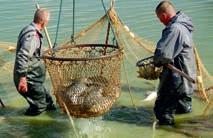
Bucharest, Romania
23-24 May 2023
Fish is among the most environmentally efficient sources of animal protein on the planet. Increased aquaculture production in Europe and globally is a sustainable way of providing protein to some of the 8.5bn people expected to populate Earth by 2030. The conference will feature sessions on freshwater aquaculture, saltwater aquaculture, and markets and certification with presentations from international and local experts. More information and free registration: http://aquaculture-ro.eurofish.dk/
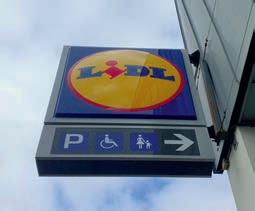
Half-century old budget food retailer Lidl, with supermarket operations throughout Europe and in North America, has decided that meat proteins will play a smaller role as it works toward global sustainability and food security in its corporate mission. Our mission is largely a response to customer behavior, said the company’s chief buyer, Christoph Graf at the recent International Green Week, in Berlin. Lidl is reacting to and supporting consumer choice, he said, not dictating how people should live their lives. In addition to supporting individual choice, Lidl believes its strategy will serve the interests of the planet: to feed the 10 billion people expected by 2050, the
world’s food resources need to be more carefully managed.
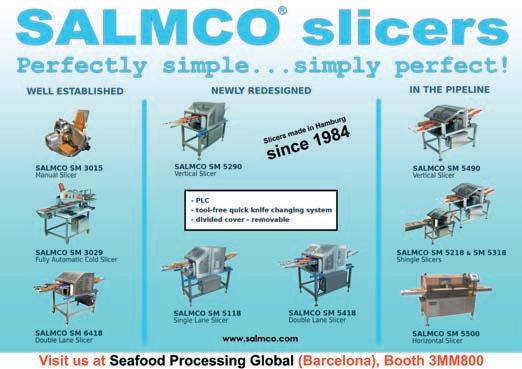
Vegetarian and vegan alternatives will gradually replace animal-based foods through 2025 and beyond. Lidl believes meat production is not an environmentally sustainable activity. It will issue a report later in the year from a study it commissioned on the sustainability of different animal- and plant-based foods, showing how a move to plantbased foods can lessen adverse environmental impacts. It is about motivating people to eat products other than meat, Graf said. As a result, Lidl would be holding more themed weeks to promote meatless products.
European aquaculture production of African catfish (Clarias gariepinus) is small but growing. This species is a member of the Clarias genus of air-breathing catfishes, with long, eel-like bodies and, unlike many fish, an ability to make sounds (they croak). Hungary is the largest EU producer, with volume exceeding 5,000 tonnes per year. The northwestern Hungarian town of Kisbajcs hosted recently an event for companies, research organizations, and representatives of government involved in African catfish farming, to brief them on the status of a project called iFishIENCi (Intelligent Fish feeding through Integration of ENabling technologies and Circular principle) that was begun in 2018 with 16 partners from seven European and one Asian country (Malta as coordinator, plus

Norway, Greece, France, Denmark, Spain, Hungary, and Laos), and financially supported by the EU research and innovation funding programme Horizon 2020.
Significant and sustainable growth in aquaculture is the goal of the Horizon 2020 program, by developing more efficient production technologies that leave a smaller “environmental footprint.” Hungary is represented in the project by Bajcshal Kft (formerly Gy ri El re Fisheries Cooperative), Vitafort Zrt, and the Hungarian University of Agriculture and Life Sciences (formerly Szent István University). Research is ongoing in the areas: digital data acquisition, analyses and AI control systems; new complex intensive fish rearing system (SmartRAS); integration of waste recovery concepts;
Hungary’s annual production of African catfish reaches more than 5,000 tonnes, which ranks the country as the largest producer of the species in the EU. Six major producers of African catfish responsible for 90% of the volumes participated in the event, underlining its importance and relevance to the Hungarian industry.
and testing new protein sources (algae, yeast). Further research in Hungary is on intelligent feeding technologies and the optimal utilization of feeds, as feeding African catfish currently accounts for 65-70 of their production costs. Participants found
the event in Kisbajcs “fruitful and beneficial,” with information on potential solutions for challenges and on the latest developments. The event included a farm visit and an informal discussion, as well as a tasting of African catfish products.
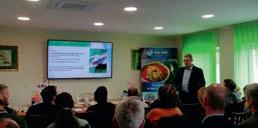
Costa Brava, on the northeast tip of Catalonia, is known for its scenic Mediterranean vistas and beach resorts along a vibrant seashore, but its economy has long depended significantly on fisheries, producing local products marketed to local consumers. While, as time passes, older people, especially women, seem to maintain preferences for fresh fish from traditional fishmongers, many younger people, for reasons of cost or convenience, do not. This perception is confirmed in a study of seafood consumption in Costa Brava, finding that consumption of seafood, especially local products, lags among the younger population. This result has led many observers to urge that marketing and education should direct more effort at this important demographic group.
The study from the University of Girona notes campaigns are already underway to promote local seafood, with labels such as “La Mar de Bé” (“The Sea of Good”, to associate seafood with satisfaction) and local initiatives such as the Espai del Peix, a fish interpretation center, and gastronomic classrooms, which are a growing trend on the Costa Brava. Such campaigns are promoted by local governments, among others. The study was prepared by researchers in the Department of Business, University of Girona, with funding from the European Maritime and Fisheries Fund. The report is in Catalan with summaries in Spanish and English, available at https://museudelapesca.org/ docs/estudi-tecnic-compra-peixfresc.pdf.
Though the consumption of fish and seafood in Spain has been declining over several years, the country remains the EU’s second largest market (after Portugal). In 2020 per capita consumption of fish amounted to 44.21 kg in live weight equivalent.


A large jump in US salmon imports has caused Europe to fall to 2nd place as a market for Norwegian seafood exports. Data for January 2023 from the Norwegian Seafood Council (NSC) indicates exports of all seafood from Norway to the US jumped by 41 over the same month a year earlier, to NOK 1.15 billion (EUR 103.6 million). Most of this increase in export value consisted of salmon. The growth in export value to the US appears attributable to currency exchange rates, among other causes. Both the US dollar and the euro have risen against the Norwegian krone in the last year, and the impact of the rising value of these currencies is demonstrated by the fact that the quantities of Norwegian exports to the US and EU have actually fallen in recent

months. The dollar rose against the Norwegian krone in 2022, with the latter recovering only slightly in December; the euro/ krone exchange rate followed a similar path. The decline in the krone helps offset generally rising seafood prices in many markets abroad, making Norwegian product more affordable to American and European customers that use either the dollar or euro, or currencies linked to them.
Yet another cause of high Norwegian exports to the US is reduced US supply from other sources, namely Chile and Canada. Combined with growing post-pandemic US consumption of restaurant seafood, the resulting demand-supply gap in the US market has been readily accommodated by Norway.

Like most birds, a cormorant eats its weight in food every day. Unlike most birds, the cormorant’s preferred food is the same fish species that are harvested by Estonian and other Baltic fishermen, species whose populations are already in decline from multiple causes without the added pressure from hungry cormorants. Estonia’s cormorant
population is growing, despite an annual hunting season. According to the Department of the Environment, there are more than 34,000 pairs of this bird nesting in the country. At around 3 kg per bird, eating at least their weight in fish each day, 34,000 pairs of birds mean a loss in fish biomass of around 204 tonnes per day, or
Salmon is the second most consumed seafood species after shrimp in the US. According to NOAA, annual per capita consumption of salmon in 2020 reached 2.83 pounds (1.28 kilos).
A smarter global standard for safer and more sustainable farming practices that covers all stages of production.
One cormorant eats 400-600 grams fish every day, and two million European cormorants need about 365,000 tonnes of fish every year. This is about 10% of the total landings of wild catch in the EU, and about the combined EU’s annual production of salmonids and freshwater fish.
nearly 75,000 tonnes per year. The department, led by Rainer Vakra, has agreed to allow fishers two measures to reduce
their losses: one is oil spraying of cormorant eggs, which prevents the eggs from hatching; the other is the use of noise
devices and lasers, which scares the birds away. Vakra added that in a few months the department will approve a multi-year action
plan to address this problem that is upsetting the Baltic ecosystem in addition to fishermen’s wallets.

In the European Green Deal, the EU Commission has set the laudatory goals of a 30 cut in the EU fishing fleet’s greenhouse gas emissions by 2030 from 2005 and transitioning the fleet to become climate neutral by 2050. Many countries are well on the way by, for example, scrapping ageing vessels that may be serviceable but are fuel-inefficient, but some see the costs as daunting. A new report by Oceana, “A pathway to decarbonize the
EU fisheries sector by 2050,” describes several solutions that make the EU goals realistically attainable. These solutions range from the broad—removing fishing methods such as bottom trawling that besides stirring the ocean bottom and releasing greenhouse gases, are so fuelinefficient that vessels currently require government subsidies to stay in business anyway—to the narrow—support for new technologies in hull and engine
design, promotion of electric over hydraulic mechanisms, and even simple improvements in preventive maintenance schedules, all of which can reduce vessel fuel consumption. These technologies already exist but their implementation requires EU assistance.
Oceana’s report is available at https://europe.oceana.org/reports/ a-pathway-to-decarbonise-the-eufisheries-sector-by-2050/.
The report offers several solutions that make the EU goals for a climate neutral fishing fleet by 2050 realistically attainable.

The 1,619 sq km Curonian Lagoon is shared by Lithuania and the Russian enclave of Kaliningrad Oblast, and is separated (barely) from the Baltic Sea by a thin strip of land called the Curonian Spit. It is a diverse body of freshwater with populations of perch, pikeperch, eel, and other species, but quite polluted and subject to heavy fishing. According to scientists from the Marine Research Institute of Klaipeda University,
fish stocks, especially pikeperch stocks, are rapidly declining, due partly to overfishing. Beginning 17 January, new rules by the Lithuanian Ministry of the Environment ban the use of 40-44 mm nets in the lagoon, a curtailment of a key gear type for the area’s commercial fishermen. It is hoped by all stakeholders that these measures will help improve the stocks of various fish species common in this reservoir.

Despite an initial hammering caused by confusion and uncertainty surrounding Brexit, seafood exporters are bouncing back, with Scottish salmon becoming the largest food export from the Kingdom. While down by 2 from the record 2019 sales value of 529 million, Scottish salmon exports in 2022 totaled EUR 506 million, to surpass export value of any other UK food product. Salmon was shipped to some 54 countries, with France receiving the most, although that includes
some product moving further to other EU markets. Overall, sales to the EU were 64 of the export total, with strong markets in the U.S. and in Asia. Farmed salmon is big business in Scotland, supporting 2,500 jobs directly and an additional 10,000 jobs in related industries. However, these jobs did not benefit from growth in export value, because volume declined sharply (-26) from 2019 levels, due to the various difficulties faced by the seafood industry in recent years.
In 1992, Scottish salmon was the first non-French product to be awarded the Label Rouge quality mark, the official endorsement by the French authorities of the superior quality and taste. In 2004, Scottish salmon gained Protected Geographical Indication status (PGI) granted by the European Union.
WE WELCOME YOU TO OUR BOOTH IN HALL 3, NO. 3BB301 AT FIRA BARCELONA
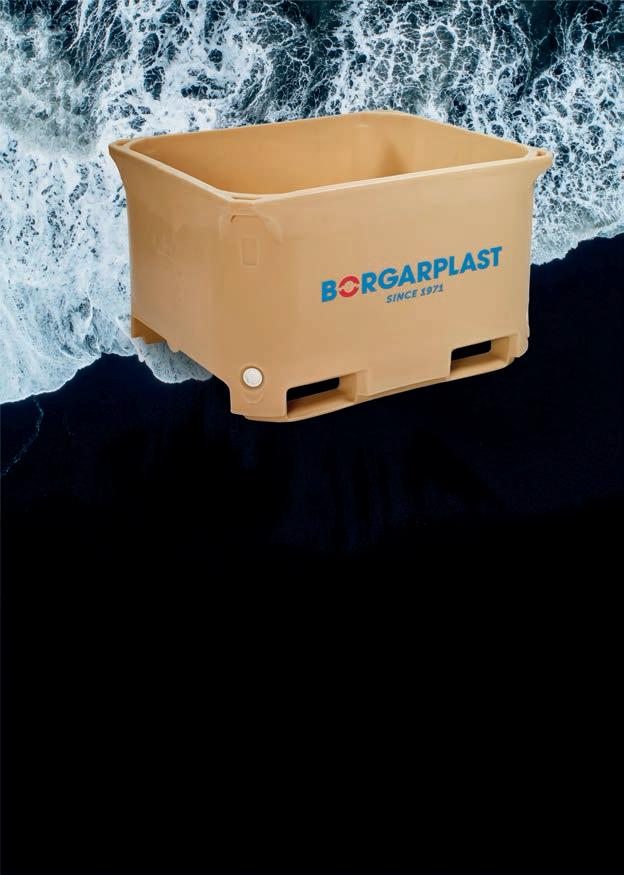
Ingka Investments, the retailer IKEA’s financial arm, has moved for the first time into the “blue economy” by investing EUR 30 million in the Ocean 14 Capital fund, according to an Ingka press release. Headquartered in London, Ocean 14 Capital launched its fund in November 2021; it is now a EUR 150 million impact fund focused on driving a sustainable and regenerative blue economy. Using the UN Sustainable Development Goal 14, Live Below Water, as its guiding principle, the fund attracts investors such as the European Investment Fund, the Principality of Monaco, Ingka Investments, and others with its commitment to support entrepreneurs and businesses with ideas for aquaculture and alternative proteins, reducing plastic waste pollution, protecting ecosystems and marine flora, and ending overfishing. IKEA’s corporate mission of “creating a better everyday life” – in this
Ocean 14 Capital plans that about two-thirds of the funds be used to invest into companies in Europe, and one third will go to the rest of the world.
case by improving ocean health – is furthered by its investment in the fund. “Our aim is to invest

with impact, delivering positive returns for communities and the environment for generations
to come,” said Samuel Rundle, Head of Financial Market Investments at Ingka Investments.

A famously deadly fish is saving the financially struggling fishermen of the Japanese prefecture Fukushima, site of the disastrous nuclear energy plant meltdown in 2011 caused by an earthquake and a subsequent tsunami. The impact on the fishing industry in following years was huge. At the Matsukawaura port, 50 kilometres north of the Fukushima No. 1 nuclear plant, fisheries landings quickly dropped by 80 from pre-2011 levels. In the years since the plant meltdown, fishermen in the area have been subject to tight restrictions and consumers have shied away from locally produced food of all types over fears of contamination.
But one population is arriving at fishing docks in hordes: tiger puffer, or fugu (Takifugu rubripes), the seafood delicacy that is deadly if improperly prepared, requiring chefs to be trained and licensed in the skill to cut away the liver and certain other toxic organs in the fish. Globally warming seas have driven fugu northward, and they are filling the fishing grounds off Fukushima. At the same time, catch restrictions have eased following testing for radiation levels, and thus the prefecture’s fugu catch has grown tenfold since 2019. Boat crews at Matsukawaura regularly unload buckets overflowing with fugu, whereas a few years ago there were very few landed in the port.
Fugu has been consumed in Japan since 200 BC. It is estimated that the Japanese eat about 10,000 tonnes of fugu every year, and about 20 people a year get poisoned from it. Fugu is the only dish that cannot be served to the Emperor of Japan, and it is also banned in the European Union.
Seafood Expo Global/Seafood Processing Global, 25-27 April 2023, Barcelona
Seafood Expo Global (SEG) and Seafood Processing Global (SPG) together form one of the largest seafood trade events in the world. Co-located at Fira Barcelona Gran Via Venue the two events are held annually in Barcelona, Spain, and attract a diverse range of exhibitors, buyers, and industry professionals from across the globe. The events provide a platform for seafood suppliers to showcase their products and services to potential customers and network with other industry players.
Organised by Diversied Communications, a media company based in Portland, Maine, USA, SEG features a vast array of seafood products from various countries, including fresh, frozen,

for processing, packaging, chilling and freezing, sanitation and hygiene, as well as on services including quality assurance and logistics. e events also include educational and informative sessions covering topics such
e events provide an opportunity for businesses to expand their reach and enter new markets by meeting with potential buyers and distributors from all over the world. ey are also an excellent opportunity for indus-
that can help improve their businesses.
In recent years, SEG/SPG have placed a greater emphasis on sustainability, as concerns about over shing and environmental
Defrosting
Tumbling
































Pressing
Slicing
Mixing & Grinding
Forming


Pasteurization

Separation
Perfect separation of whole fish, frames, eggs and trims
STS Belt Separator – different sizes of Soft Tissue Separator
• Highyieldseparationoffish
• Choiceofmanualoperationorour patented automaticcontrols


• Hygienicandeasy to maintain
• Includesoversized hopper in-feed for auto feeding

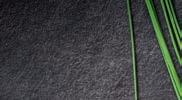


Contact us info@provisur.com or Tel. +33 298 94 89 00
provisur.com
features several sessions focused on sustainable seafood practices and showcases innovative
products and solutions that can help reduce the industry’s environmental footprint.
The Eurofish member countries are usually well represented at the two events and 2023 will
be no exception. Some of the national pavilions are previewed here.
used to raise common carp in polyculture with grass carp and European cat sh. Common carp accounts for about three fourths of the production in carp ponds, with grass carp, European cat sh, and other species comprising the rest. Trout production has averaged some 370 tonnes over the four years to 2021 with minor uctuations.
The Croatian sheries sector is highly diversi ed with a variety of species caught and farmed. Wild small pelagics such as anchovies and sardines represent the bulk of the landed volume with small quantities of cephalopods, crustaceans, and bivalves making up the balance. Total catches have been broadly stable over the four years to 2021 with
a slight dip in catches of small pelagics in the last year. Production from marine aquaculture has increased each year over the same period. Several marine species are farmed in Croatia of which seabass and seabream dominate with fattened tuna coming close behind. Limited volumes of other n sh species such as meagre are also produced as well as modest
volumes of mussels and oysters. e trend for all the marine farmed n sh species has been positive over the four years to 2021, according to the Croatian Bureau of Statistics, while mussel production has been stable.
Inland in continental Croatia is a freshwater sh farming industry focused on carps and trout. Earthen ponds are
e Croatian pavilion at Seafood Expo Global in Barcelona will once again be organised by the Croatian Chamber of Economy and will host nine of the most export-oriented seafood companies in Croatia. e companies represent the di erent facets of the Croatian sheries and aquaculture sector and will include those that catch or process small pelagics, farm tuna, seabass and seabream, or freshwater species. Canning companies and sh traders will also be present. Croatia imports sh from other countries in Europe to sell on the domestic market to the local population and the millions of tourists that arrive in the country each year. At the seafood show it will be possible to sample some typical Croatian seafood including salted and marinated sardines and anchovies as well as value added products based on seabass and seabream.

Poland will have a large pavilion at Seafood Expo Global highlighting its status as Europe’s most important sh processing nation. e Polish processing sector is a major supplier of processed sh and seafood products to the rest of Europe while at the same time trading on the large domestic market. Polish companies at the Barcelona
event will be spread over several halls though the main Polish pavilion will be in 4G301. With a long tradition of shing and seafood production Polish companies will exhibit a wide variety of products from smoked salmon to octopus salad. One of the highlights of the Polish pavilion is its range of smoked sh products. Smoked salmon is a particular
speciality, and visitors can try a range of di erent varieties, from mild and delicate to rich and smoky. e pavilion also showcases smoked eel, trout, and mackerel, all of which are produced using traditional methods and recipes.
Another feature of the Polish pavilion is its range of pickled and
marinated sh products. Pickled herrings are a particular favourite, and the pavilion o ers a range of di erent marinades and avours, from classic dill to spicy paprika. Visitors can also try pickled mussels, which are a popular delicacy in Poland, as well as marinated anchovies and sardines. In addition to these traditional seafood products,
e Croatian pavilion at Seafood Expo Global will feature companies with products that represent the diversity of the country’s seafood sector (archive photo).the Polish pavilion also showcases some more innovative and modern dishes. Octopus salad is a particular favourite, featuring tender pieces of octopus combined with fresh vegetables and a zesty dressing. ere are also a range of seafood pates, spreads, and dips on o er, perfect for serving as appetizers or snacks.
e Polish presence at Seafood Expo Global comes despite the challenges facing by the processing sector due to the war in Ukraine. e con ict has resulted in an increase in prices for most inputs including energy, raw materials and labour and has disrupted supply chains and lowered demand for Polish products in the east as well as in parts of the EU. Despite these constraints visitors can expect to see and taste the full range of sh and seafood processed in Poland.
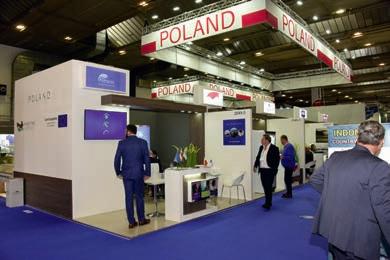
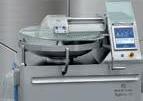

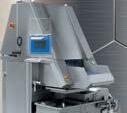



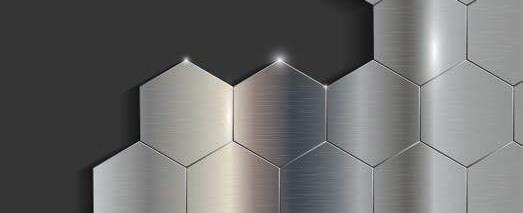


Denmark: 3CC201, 3DD201, 3EE201, 3EE401, 3FF401, 3PP202
Sustainability is a key word for Danish companies joining the Pavilion of Denmark at Seafood Processing Global (SPG) 2023 in Barcelona. irty-one companies will be ready in Hall 3 showcasing technologies and solutions targeted respectively towards aquaculture, shing, and processing of sh and seafood.

“Spain is home to the largest sh processing industry in Europe, thus Spain as a market for the segment in itself is representing an obvious and huge potential for Danish suppliers of technology, solutions and equipment to the shing industry. SPG furthermore gathers decision makers and stakeholders from the entire international shing industry making the exhibition attractive for
Danish suppliers” says Martin Winkel Lilleøre, Head of the Fish Tech network at Danish Export Association.
Solutions presented at SPG will for instance include equipment and machinery for handling and processing of both sh and shell sh, freezing solutions, hygienic transport band solutions, analytical equipment, equipment for transformation of sh by-products and smart packaging solutions. e Pavilion of Denmark will also present solutions for re-use of packaging contributing to the circular economy of the shing industry.
Danish company Beck Pack Systems which produces packaging for the
frozen sh have been part of the Pavilion of Denmark many times presenting their core product, the Beck Liner. e company has an increased focus on sustainability and bringing green solutions to the exhibition.
“ e product has basically been the same for years, and we’ve gained market shares because of the quality of the product. Sustainability is also a growing focus for us. I wouldn’t hesitate to say that we are front runners with regard to sustainability in an international perspective. Our product is biodegradable, and we are currently working on nding ways to recycle our used products. In that process we are working together with a number of partners in different industries all over the world,”
says Jesper Kjøller, sales manager at Beck Pack Systems.e focus of SPG has traditionally been set on the sh and seafood processing, but in recent years that has expanded to cover the entire value chain of the sheries sector. Aquaculture and shing industries have received increasing attention at SPG, covering technology, solutions, and equipment such as pumps for gentle transfer of sh, lter solutions for RAS facilities, monitoring solutions, and equipment for sustainable sheries.
Instead of tapping your phone to mark all the booth numbers in your Seafood Processing Global app simply raise your head, go to Hall 3, and look for the bright red and white sign that says “Pavilion of Denmark”!Canned sh has always been Latvia’s hallmark. is year at the National Pavilion of Latvia in Barcelona companies will be showcasing a wide range of canned products, including herring, salmon, sardines, trout, mussels and, of course, Latvia’s signature product – smoked sprats in oil, which have been produced since the 19th century. Latvian sprats are made only from sprats and small herring of a certain size, caught in two speci c areas of the Baltic Sea during a certain time of the year.
e development of the technologies has not in uenced the production
process: Latvian sprats have remained unchanged for well over a century – handmade, unique, iconic. New technologies, however, have had a signi cant impact on the packaging. Modern Latvian sprats, as well as other canned sh and seafood are often packed in cans with transparent lids, or even in glass jars allowing a customer to see the beauty of the product inside.
Latvia’s seafood processing sector also reacted to the growing demand worldwide for vegan products and the general concern about sustainability – and now companies produce plant-based

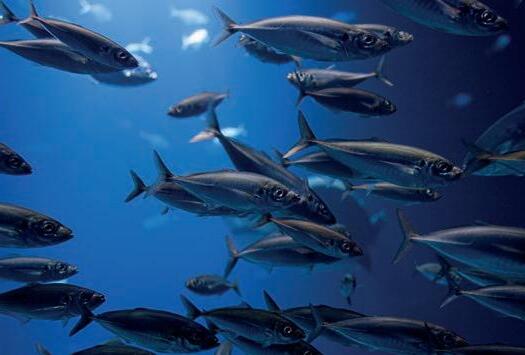
Latvia’s seafood sector is famous for its canned products. In recent years the country’s exports of canned sh reached almost 60% of the total seafood export value amounted to over 100 million euros (archive photo).
“ sh” products available to the customers both domestically and abroad.
e o cial organiser of the Latvian pavilion is the Institute of Agricultural Resources and Economics (AREI), and this year the joint stand will host 12 companies that will present--besides canned and plantbased products-smoked salmon, surimi products, “red caviar” made
of salmon roe, as well as frozen and chilled sh.
During all three days of the show the chefs at Latvia’s National Pavilion will prepare samples of the products showcased by twelve companies, and visitors are welcome to come and taste the best Latvian products – whether their history dates back two centuries, or two years.
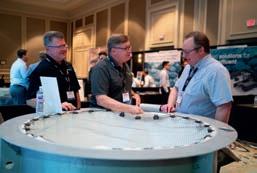
Whether it’s raising fish juveniles, smolts, or market-sized fish, the RASTech 2023 conference and trade fair covers the latest developments, innovations, and research in land-based fish farming.
Recirculating aquaculture systems are increasing in popularity as the attraction of reducing water consumption to breed sh becomes clearer. is however is only one of the bene ts these systems o er. Lower risks of diseases, full control of each stage of the production process, and less likelihood of escapes are among the other advantages. On the other hand, these systems are complex and require trained personnel to manage them. e potential and challenges associated with RAS are highlighted at an event dedicated to the industry. RASTech will be held this year at the JW Marriott Orlando, Grande Lakes, in Florida, and will comprise three tracks—business, operation and research—that will allow attendees to delve deeper into the many facets of the recirculating aquaculture industry.
e business track is geared towards those who are interested in learning more about what it takes to run a successful RAS business. e operation track is about sharing technical knowledge used in a facility, while the research track brings together the latest studies that drive the industry’s innovation and development. e schedule is updated regularly to help attendees make the most out of their conference experience. Top industry experts and executives from the world’s
leading aquaculture companies will be on-hand to discuss and share their experiences and knowledge. Day three of the conference will involve a tour of the Evans Fish Farm. e 100-acre sh farm located in Pierson, Florida, is one of the rst complete sturgeon aquaculture operations in the United States.
Among those lined-up as event speakers are: Sylvia Wulf, CEO and president of AquaBounty Technologies; Yonathan Zohar, project director of RAS-N & SAS2, and presidential professor and chair of marine biology at the University of Maryland; Siri Tømmerås, commercial director, land-based, at AKVA Group; Yoav Dagan, partner and vice president of business development at AquaMaof Technologies; Karl Øystein Øyehaug, CFO of Atlantic Sapphire; Chris Good, director of research at the Freshwater Institute; Tracy Navarro, president and general manager of Trader Hills Farm; and more. “ e RASTech Conference and Trade Fair is a one-stop-shop for the RAS community. is unique RAS event is a place for people to learn about the business, operations, and innovative research while networking with experts from around the world,” said David Kuhn, event coorganizer and founding partner of Virginia Tech.
Day 1 keynote will include insights on “Lessons learned” from
speakers Per Heggelund, consultant and investor owner of Nordic Partners LLC; Justin Henry, consultant at Henry Aquaculture Consult Inc., and chief technology o cer of West Coast Salmon; Karl Øystein Øyhaug; and Sylvia Wulf. Other sessions for this day will feature RASTech editor Jean Ko Din, who will moderate a series of sessions about creating a RAS business model; Marianne Naess of Xcelerate Aqua discusses recruiting and keeping talent; and Yonathan Zohar, will lead the RAS-N and SAS2 sessions.
On day 2 Martin Gardner, president of Blue Ridge Aquaculture; Geno Evans, CEO of Evans Fish Farms; Eric Pederson, president and founder of Ideal Fish, will provide the keynote and will make a case for vertical integration. Other speakers for this day include: Jaime Stein, co-founder of Devonian Capital, who heads
o the Investors’ Forum; Kathleen Hartman and Bill Keleher discuss sh health and welfare; Dianne Fletcher, communications specialist for King sh Maine, speaks about brand building; and Huy Tran, senior biologist and co-owner of Aquatic Equipment & Design, will talk about aquaponics. “Our trade show has grown from 50 to 80 exhibitor booths this year re ecting a real appetite from industry suppliers wanting to play their part in this expanding segment of aquaculture. It’s a great opportunity for attendees to check out all the latest RAS products and equipment options for their RAS project or existing operations. It’s like a onestop-shop for RAS,” according to Jeremy ain, RASTech associate publisher.
For more information about the event including the programme of activities visit https://www.rastec.com/.
RASTech 2023 combines a conference and a tradeshow with a visit to a sturgeon farm on the final day. RAStech Magazine














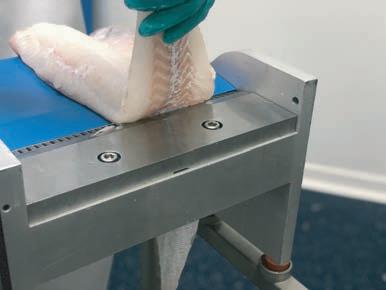


 Automatic Skinner
Tabletop Skinner
Automatic Skinner
Tabletop Skinner
AquaFarm, NovelFarm, AlgaeFarm 2023, 15-16 February 2023, Pordenone

Pordenone Exhibition Centre continues to be the world’s reference venue for events dedicated to innovative and sustainable food production in water and on land. The 2023 edition of the three events AquaFarm, NovelFarm and AlgaeFarm ended with impressive numbers. Visitors increased by 62% compared to 2022 and by 25% when compared to the last pre-covid edition. The events drew 130 exhibitors, 33% from abroad, and used almost 7,000 square metres of exhibition area in Halls 4 and 5.
As usual, the highlight of the three events was their content. With over 30 conferences scheduled featuring 150 speakers from all over the world, listeners were treated to the most up-to-date information from various sectors.
AquaFarm focused on the two big problems faced by sh and shellsh farmers at the moment: rising energy costs and climate change. Potential solutions include adapting to change on one hand and providing for one’s own energy needs through self-production on the other. Adopting both in synergy could prove decisive for a farm’s prospects. Supporting livestock farmers in these demanding activities are, as always, the EMFAF funds, which in this EU budget cycle have seen the A for aquaculture added to the F for shing. A popular session with companies, EU o cials and regional councillors explored the characteristics, requirements and scale of funding coming through the regions. On a more scienti c note, there was great interest in the session on the sh microbiome and its modulation through feed and probiotics, which, according to many experts, is the
future of nutrition in aquaculture. ere was no lack of technology and end product market sessions, which featured a series of fascinating company stories about the constant search for quality and innovation.
NovelFarm is a unique event in Italy for its exclusive focus on soilless and vertical farming, general topics that o er a chance to discuss issues of great interest to the Italian “grower” community. To give just an example, genetics and varietal selections for vertical farming have led to a demand
from researchers and companies to open the door to research also in Italy on NBTs, the New Breeding Techniques, starting with the applications of CRISPR. e objective is not just to obtain attractive varieties for the market faster, but to re-domesticate cultivated species and introduce novel ones with great potential for the new growing environment represented by vertical farms. Meanwhile, soilless continues to grow. It is considered a strategic factor also by the FAO to sustainably and safely feed the world’s population. A large consumer segment has already adopted it as a primary technique for its needs, which focus on shortening logistics chains, eliminating
residues, delinking supply from seasonality, and adapting to the public’s demands in almost real time, as was discussed in a session organised in collaboration with FreshCut News. Non-food crops have long been grown on vertical farms, e.g. medicinal plants, high-quality fodder for calves, and even those species that can be used as “molecular factories” for active ingredients, industrial substances and even vaccines and antibiotics. ese were all themes at a very well attended session. Technological evolution also o ered novelties in this edition, starting with the new technique of photonics, the development of aeroponics, the increasing sophistication of
Perfect product quality and maximum yield: Smoking and drying systems from REICH for lying or hanging fish optimize your products and your profit. Today, REICH is a global leader of thermal processing systems for fish. Convince yourself in our technology center in Germany!
www.reich-germany.de

lighting and fertigation strategies, and automation.
Finally, AlgaeFarm, the main event of a sector that is economically growing in Italy but, above
all, is strategic for the shift of the global economic system in a direction that has less impact on the environment. Here the main topic was the domestication of microalgae, which, unlike in agriculture, are bred in their “wild” form. For many experts, the future of microalgae lies in this revolutionary new step. A talk by
the Los Alamos-based New Mexico Consortium of Research Institutions and Operators, which is blazing new trails in solving one of the main limitations of microalgae cultivation: the biomass yields, which are still too low to provide widely used products at an acceptable cost. at kind of research is not well-known in
Europe, even among specialists, and it is pertinent that AlgaeFarm provided an opportunity to discuss the issue.
For more information about the three events, contact: Simona Maldarelli, Pordenone Fiere, smaldarelli@ erapordenone. it, +39 380 3133728
Finding carbon neutral ingredients for fish feeds and experimenting with multitrophic aquaculture are among the ways researchers are trying to make Italian aquaculture more sustainable.
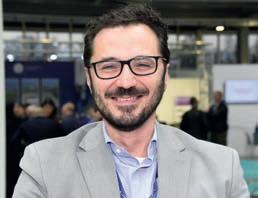
As sustainability gains increasingly in importance it also a ects companies in the aquaculture sector which, as a consequence, are working to make their operations more environmentally friendly. Aquaculture feeds were responsible for 60-70 of the carbon footprint of the aquaculture value chain when shmeal and sh oil were the main ingredients in sh feed. And sh farming operations a ect the natural environment due to their biological and chemical impacts.
Today, however, the use of shmeal and sh oil in sh feeds is very ecient. From the main constituent of a feed, they are now used in much smaller volumes, as an additive to increase palatability or to add certain amino acids to the feed. Yet advances in feed technology enable a feed conversion ratio that gives about 5 kg of sh for each kilo of feed, says Prof. Alessio Bonaldo from the University of Bologna.
Antibiotic utilisation, a source of chemical impacts, is decreasing year by year and already many farms are certi ed antibiotic-free. In addition, genetic selection can select strains that are more resistant to diseases and pathogens— which also reduces antibiotics use. Multitrophic aquaculture combines the production of sh with that of seaweed or molluscs which absorb the nutrients released by the sh farming. is makes the sh production more sustainable and at the same time creates an additional product (seaweed or molluscs) for sale.
Another technology that reduces water and energy consumption is recirculated aquaculture systems. ese are used already in hatcheries for the production of juvenile sh, but as the climate gets hotter and drier farmers are becoming more interested in these systems for the production of market-sized sh. e aquaculture industry in general is very interested in reducing its impact on the environment because, as Prof. Alessio Bonaldi
says, the connection between farmed sh and the natural environment is very close. Unlike terrestrial farmed animals which are housed in buildings separated from the environment sh are farmed in the sea where there is no such separation. Fish farmers and feed manufacturers therefore try to reduce their products’ impact on the marine environment as far as possible.
One way of doing this is to nd ways of substituting shmeal and sh oil with other ingredients. Prof. Bonaldo is involved in three projects. NewTechAqua seeks to use by-products and coproducts from sheries and aquaculture such as trimmings and other
leftovers from slaughtering and processing operations. ese ingredients were enriched with algae to balance the omega-3 content in the diets. In another project, NEXTGEN Proteins, the researchers tested insect meal, algae meal and single cell protein from yeast. One of the objectives of the project was to replace the shmeal and soya meal content of sh feeds. In SUSTAINFEED the purpose was to test plant ingredients, coproducts or by-products from other value chains, that do not compete with human consumption. In all three projects the feed products were tested for performance, sh welfare (especially gut health), and llet quality. e
results suggested it was possible to decrease shmeal content and the fraction of other more unsustainable substances with the new ingrdients. e results also showed that seabream in particular is able to convert low quality proteins into good animal proteins without detrimental e ects on welfare or llet quality. e new ingredients were circular in the sense they were produced from coproducts or by-products coming from another value chain. For example, the yeast in the NEXTGEN Protein project were fed with waste from the forestry industry. is circularity adds value in terms of carbon footprint and nutrient valorisation.
The department of Veterinary Medical Sciences at the University of Bologna has a centre for blue growth that is physically located in the village Cesenatico on Italy’s Adriatic coast. All aquaculture-related activities—education, training, and research—are concentrated here. The centre offers a bachelor’s degree in aquaculture and hygiene of fish products that was initiated 25 years ago and is the only one in Italy dedicated to aquaculture, according to Prof. Alessio Bonaldo. Students learn everything from anatomy and physiology of aquatic animals to pathology and economics is also a subject. Between 40 and 50 students graduate each year and most of them find work immediately. The centre has its own facilities to run trials on live animals like fish, mainly on fish nutrition, but also on reproduction, and it also offers training courses, summer schools for technicians or farmers or people from the feed industry. The course language is currently Italian but changing it to English is under consideration to attract more foreign students.
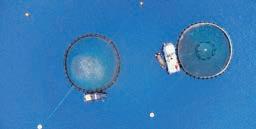
Apart from the environmental goals the purpose is also to try and maintain feed costs at a stable level for the sake of the sh farmers who face price increases for all their inputs. Feed is the most signi cant cost for them accounting for up to 60 of the total. Any increase in feed prices has thus a major impact on their costs. One way to reduce production costs that is also being considered is by cultivating omnivorous or herbivorous species. e challenge is consumer acceptance. More generally it is important to look at the entire value chain from production to processing to marketing when considering new species. In Italy new marine n sh species under
trial include dusky grouper, amberjack, shi drum and mullet, says Prof. Clara Boglione from the University of Rome Tor Vergata. Mullet is grown mostly in the lagoons of Venezia and Sardinia, but it is scattered and the volumes are small. Greater amberjack and Mediterranean tuna are cultivated in Sicily but with irregular production. So, essentially, sh aquaculture in Italy is focused on seabass, seabream and shi drum in the sea and trout and sturgeon in fresh water. However, experiments are being conducted in the framework of community-like aquaculture, where sea cucumbers and sea urchins are reared in combination with marine species. is is a form of multitrophic aquaculture, where the sea cucumbers and sea urchins are grown beneath the sh cages or mussel longlines to mitigate the impact of the nutrients released by
•
www.jpklausen.com

Youronestopsupplierforseafood: Hokiproducts
• NZDory fillets
• Once frozenAlaskan Pollock and once frozen PacificCod Mackerel Herring Surimi Base. •••
Please alsodonothesitateto askforspecialties like: NZ Ling fillets
• Blue Mackerel • Savorin • Silver
Warehou Blue Warehou
• • Brotola • Alfonsino • Arrow
Squid • Southern BlueWhiting Orange Roughy • Giant Squid
Yellowfin Sole
NEW:
Northern Blue Whiting Rock sole. •
MSC Australis Hake


the reared organisms. e two species are valuable products themselves and represent an additional income stream.
Prof. Boglione specialises in analysing the impact of rearing conditions on the sh skeleton. In the past, she has described how semi-intensive rearing conditions (characterized
by large tanks coupled with low stocking densities) are able to produce juveniles of gilthead seabream, European seabass and dusky grouper with body shape and pigmentation similar to that of wild sh and with fewer deformities than are found among juveniles raised in intensive rearing conditions. In the framework of the BioMedAqu project, she collaborates with the University of Las Palmas to analyse the e ects of dietary vitamin D3 levels and dietary supplementation of
copper on gilthead seabream skeleton. In the same project, the collaboration with the University of Las Palmas, University of Algarve, IPMA (Instituto Português do Mar e da Atmosfera) and API (Associazione Piscicoltori Italiani) demonstrates better survival and growth rates, and lower incidences of some skeletal anomalies when gilthead seabream larvae and pre-ongrowing juveniles are reared in low-density conditions. e quality when you rear at low density is much better,
she says, but convincing farmers that it is better to breed fewer high quality sh rather than many of lower quality is not an easy task. Some farmers do rear juveniles at low density and then sell them at a higher price. Most, however, rely on the cheaper intensively reared juveniles. is is partly because the rapid market expansion in the 1980s with the subsequent oversupply from Turkey and Greece has lowered the market value of gilthead seabream over the last two decades.
Start-up determined to sever the link between aquaculture and marine resources
Ittinsect – Feed for the Ocean uses insects to create an ingredient that enables feeds to perform better and at less cost to the environment. The ingredient has been successfully tested with feeds for trout and sturgeon, and trials with seabass and seabream are ongoing.

Insects have been gaining popularity as a sustainable alternative to traditional animal protein sources such as shmeal and soybean meal. ey are easy to farm, have a high feed conversion e ciency, and require less land and water compared to conventional protein sources. Insects are also rich in nutrients such as protein, fat, and minerals, making them a valuable ingredient in animal feed, including sh feed.
Fish farmers rely heavily on shmeal and sh oil, which are obtained from wild sh stocks. is has led to over shing and depletion of sh stocks in many regions of the world. Insects can o er a solution to this problem by providing a sustainable source of protein for sh feed. Black soldier y larvae, and mealworms,
are some of the most commonly used insects in sh feed. ese insects are easily digestible and provide a balanced amino acid pro le, making them a suitable replacement for shmeal. e use of insects in sh feed has several bene ts. First, it reduces the pressure on wild sh stocks by providing an alternative protein source. Second, it reduces the environmental impact of sh farming by lowering the carbon footprint and the amount of water and land needed to produce feed.
ird, it can help reduce the cost of sh feed, which is a signi cant expense for sh farmers.
However, there are some challenges to the widespread use of insects in sh feed. One of the main challenges is the cost of production, which is still higher than that of traditional protein sources. Another is the abundance of chitin in insect meal which negatively a ects the sh’s digestion.
Black soldier fly larvae (pictured) and mealworms are among the commonly used insects for meal, but the potential of other species is also being explored.
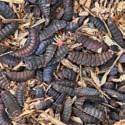
In addition, the consistency of insect meal quality may vary depending on what the insects were raised on. Despite these challenges, the use of insects in sh feed has the potential to transform the aquaculture industry and make it more sustainable. e development of an industry to produce insects to be made into meal has also spawned specialised companies that improve insect meal by making it more accessible or healthful for the sh. Ittinsect was founded by Alessandro Romano, the CEO, in 2021 to reduce pressure on the stocks of industrial sh
species that are the raw material for shmeal and oil, traditionally the primary ingredients of sh feed. Having sailed competitively since his childhood and with an educational background in naval architecture Mr Romano has long had a close connection to the sea. On a 40-day sailing trip in the Adriatic a few years ago, when he committed to surviving only on the sh he caught, he realised that there was precious little sh in the sea. is discovery led to an epiphany. Since almost a quarter of global catches by volume is used for conversion to shmeal and sh oil, he decided that his mission would be to develop a substitute that could reduce the amount of sh that is caught for industrial use.
Ittinsect is a biotech company that optimises insect meal to improve the performance of the sh feed to which it is added. We do not produce insects, says Mr Romano, we have developed a biotechnological process that improves the nutritional e ciency of insect meal making it, he claims, eight
times more bioavailable to the sh than conventional insect meal. e process the meal is subject to improves the proteins by breaking the long chains of amino acids making them more digestible using microbes, enzymes, and other biotech enablers. e process is in the process of being patented, so Mr Romano is reluctant to go into too much detail. In addition to making the proteins more digestible the process reduces antinutritional factors, like chitin. While a certain fraction of chitin in the meal is bene cial, too much of it can provoke gut in ammation in the sh. Finally, the meal also stimulates the gut of the sh to absorb more nutrients thereby accelerating sh growth. e insect meal thus processed is added as an ingredient to sh feed in a proportion that varies between 10 and 30 depending on the species and size of the sh. e company has developed a complete feed line for trout, sturgeon, and expects to launch a variety for seabass and seabream feeds shortly. ese developments helped to persuade rst class blue economy investors such as Katapul Ocean, Indico Capital
Partners, and the Italian national innovation fund, CDP Venture Capital to put EUR625,000 into the company in January this year.
At the company stand at AquaFarm in Pordenone, Italy, Mr Romano o ers visitors a taste of trout that has been fed on a feed made from insect meal supplemented with the Ittinsect ingredient. e sh is the rst in Italy to be commercially fed with an insect meal diet and has a mild taste and rm texture. Mr Romano states that the feed conversion ratio (FCR) was 18 better compared with a standard sh, and there was 3 less fat in the guts, and in a panel tasting it did better on both taste and texture than conventionally fed sh.
e improved FCR means that the sh can be grown to a given weight faster than a sh fed on a regular feed, or can reach a larger size in a given period. In addition to improvements in performance are the environmental bene ts. e insects are fed on agricultural
• Tunnel washers
• Container, bin and vessel washers
• Pallet washers


• Rack & trolley washers
• Drying systems

•
•
•
by-products which contributes to the circular economy and insect-based feeds typically emit 10-20 less carbon dioxide than traditional feeds. Ittinsect’s mission is to replace shmeal with insect meal to reduce the carbon dioxide emissions associated with the former and to ease the pressure on the sh stocks that are reduced to shmeal. e insects are obtained from European producers who follow EU regulations for insect production. is means they are mainly fed on certi ed plant-based agricultural by-products, such as from breweries or the roots of certain crops. Mr Romano hopes that in time it will be permitted to feed the insects a more varied diet. e main insect varieties cultivated in Europe are black soldier ies and mealworms, so these are also the insects that Ittinsect processes or includes in its feeds. As a biotech company it is constantly researching the potential of di erent insects, other agricultural by-products, and even
microalgae that can be treated and added to feeds. Our goal is to become an ingredients supplier to every feed producer, that wishes to reduce their carbon footprint and their impact on the marine environment and at the same time produce high performance feeds for sh farmers. e actual feed extrusion is subcontracted to a production partner but the biotech processing of the enriched insect ingredient, the formulation, the supply of ingredients, and the brand are all provided by Ittinsect.
Of the sh farmed in Italy trout has the largest volumes which made it an obvious target candidate for the company. With over 33,000 tonnes produced in 2020 (FAO) trout accounts for 70 of the nsh farmed in Italy. Trout in the wild also feed on insects, so a feed based on insect meal should be
acceptable to the sh. Sturgeon was selected because its diet particularly in the early stages is similar to that of trout. Trials carried out on sturgeon showed good results with regard to palatability, FCR, and growth. Moving to seabream and seabass which combined account for 11,000 tonnes of production will be more of a challenge as they are the rst marine species for which the company intends to create a feed. Towards the end of the year the company will start selling the ingredient on its own to salmon feed manufacturers interested in the inclusion of the ingredient in their feed. Insect meal is not, however, a cheap product. As research
continues to explore the potential of insects as a protein source for feeds, prices are expected to come down in the future as production increases, but for the moment Ittinsect’s improved insect meal’s unique selling point is the increased digestibility it o ers, the higher FCR, and the environmental bene ts. Equally important is the price of shmeal and sh oil which has increased ve-fold in the past 20 years and continues to rise as marine forage sh stocks cannot keep pace with growth in the global aquaculture industry. If prices of shmeal and oil continue to rise, switching to insect meal will soon seem like a no-brainer.
CEO: Alessandro Romano
Activity: Ingredients based on insect meal for aquafeeds
Species catered to: Trout, sturgeon, seabass, seabream
Volumes: 1,000 tonnes in 2023, commercial production to start in 2024
PerformFISH, an H2020 project that concluded last year, aimed to boost the performance of Mediterranean sea bass and sea bream aquaculture making it more productive, market and consumer driven, as well as environmentally and socially responsible. The Italian Institute for Environmental Protection and Research (ISPRA) led the work package tasked with developing a tool to benchmark the performance of the Mediterranean marine fish farming sector, based on key performance indicators (KPIs).
The tool, essentially a repository of real production data provided by the sector together with a software to carry out analyses, can be used to generate different kinds of information. For example, it allows users to compare
anonymously the performance of a Mediterranean aquaculture producer with the average of all Mediterranean producers whose data is in the system, and to identify sources of inefficiency. It can create reports on how the sector performs
from an environmental point of view, and it can promote higher technical efficiencies with lower environmental impact, among other equally useful information. The KPI system is aligned with recent guidelines from the European Commission about
building resilience and competitiveness of the sector, ensuring the participation of the sector in the green transition and increasing transparency, social acceptance and consumer information on aquaculture farming practices.
The KPI analytical tool
e tool is based on a set of key performance indicators (KPIs), quanti able measures with which a company can assess its performance over time, which were grouped into technical, welfare, environmental and economic indicators. e rst group comprised KPIs related to sh mortalities, losses and diseases, deformities, feed e ciency, sh growth etc., to measure the technical e ciency of companies. Welfare KPIs include operational welfare indicators to measure sh welfare during grow out cycles, while the environmental KPIs estimated the use of water, land, and energy as well as the impact of the production on biodiversity, and on the surrounding habitat. All told, an original list of some 200 KPIs was distilled down to 55 of which the welfare and environmental indicators totalled 9 and 14 respectively, while the rest were technical indicators. ese KPIs could be applied to the whole production cycle of seabass and seabream from the hatchery to grow-out and harvest.
e tool was developed by the ISPRA team in collaboration with

the industry and the ve sh producer associations (PAs) from Croatia, France, Greece, Italy and Spain (CCE-CA, SFAMN, FGM, API, APROMAR) representing over 90 of the seabass and seabream production in the Mediterranean EU countries, and consortium scienti c partners. It has three main components: the KPI dataset, the digital interface for data entry and the SAS® Visual Analytics, a powerful visual interface, exible and intuitive, with multiple statistical analysis and ltering options to analyse the performances of sea bass and sea bream aquaculture using KPIs.
Although data on the hatchery and the nursery have been collected, the implemented tool so far uses grow-out data as the PAs indicated that as a priority. Production data from stocking in net pens to harvest are collected at di erent growth stages so that the indicators are standardised for speci c weights of the sh.
When benchmarking the data from an individual farm it is possible to lter and analyse the data on many di erent indicators. Mortality (including mortality after 3 days,

after 10 days, or total mortality), use of antibiotics, sh losses, and all the other technical, environmental, and welfare KPIs related to
one farm can be compared with an aggregated value of those of other farms which may be in the same or di erent temperature zones. Similarly, it is possible to compare the performance of a batch with other farms’ batches from the same quarter of stocking or from di erent quarters. e tool uses a friendly set of statistical analysis to facilitate aquaculture companies to generate performances analysis of seabass and seabream on farm together with sophisticated statistical modesl as Welfare Score Index, Cluster Analysis, Data Envelope Analysis and Life Cycle Assessment.
As work package leader, ISPRA currently hosts the database, but a more long-term solution will need to be worked out for the future. Several options are under
■ Fisch-EnthäutungsmaschinemitGefriertrommel-Technologie

■ Besondersgeeignet fürweicheFiletsund Fischartenmitweicher oderdünnerHaut

■ Dünnesundtiefes Enthäutenvonkleinen undgroßenFiletsund vonAbschnitten
■ GeringeFolgekosten durchhoheEnergieEffizienzsowie moderne,reinigungsundservicefreundliche Konstruktion
consideration—it could remain in ISPRA, or be hosted by the Producer Associations, or by the Producer Organizations, or the producers may have to pay a fee.
Producers share their data—possibly for the first time ever!
Following the identi cation of a list of core KPIs and a standardized methodology for data collection on farm, the rst web interface was built to collect the production data from seabass and seabream companies. Producers are invited by their national
Producer Associations to participate in the project consortium and have been committed to the principles of transparency, trust and data sharing. e anonymization of the data was crucial as the information was con dential, and without anonymity the producers would not have contributed their data. e data can currently only be accessed by the individual producer, while the overall anonymised database was analysed and checked for data quality and validation of KPIs by ISPRA. Indicator data, mostly welfare and environmental, from the individual farms were
collected annually while technical indicator data were also collected by production batch so that a producer could benchmark one batch against another. Overall, data collection lasted 4 years and they provide an unprecedented level of detail with some 65,000 entries from 18 companies representing 400 batches between hatchery and grow out, says Francesco Cardia from ISPRA. If producers are willing to continue to enter their data, the system will become even more representative and more accurate.
For companies, the KPI tool today allows the benchmarking of sea bass and sea bream performances against the rest of the participants. For PAs the system can generate information about how the sector performs, use of resources, surface area, mortality, use of antibiotics, etc. which can provide the basis to communicate science-based messages about the sector and to increase the acceptance among consumers of products from aquaculture. However, PA’s access to the data remains to be negotiated between the PAs and their members.
For instance, the section on environmental KPIs information
entered include escapes, interaction with wild fauna, quality of sediments under the cages, use of marine space and freshwater, use of feed and chemicals for treatments. ese can be sensitive information, says Mr Cardia but, through this anonymized system, producers have the possibility of sharing them, to better communicate with consumers and to increase the transparency and trustworthiness perception of Mediterranean marine aquaculture .

Once the system is released for use by the industry, the producers willing to participate will have to upload their data which will be anonymised. This data aggregated will form the benchmark against which the individual producers can compare their performance. The system is very flexible and allows the user to widen or narrow the analysis depending on what he wants to benchmark against. For example, the quarter in which the juveniles are introduced into the cages makes a big difference to performance, says Tommaso Petochi from ISPRA, so when benchmarking a batch it makes sense to do it against fish that are from the same quarter.

A farmer can see, for example, the vaccination rate on his farm compared with the aggregate and then knows whether he is doing better or worse or the same as the other farmers. Vaccination can be compared with mortality so that a farmer can adjust his vaccination strategy if necessary. The system provides a trend of a farm’s performance and allows the farmer to set targets for improvement.
The project has also worked on validating operational welfare indicators (OWIs) relevant for seabass and seabream farmers. Following a holistic approach,
a composite welfare score index was created, enabling the first large-scale welfare assessment of seabass and seabream across the Mediterranean. The index is based on more than 20 OWIs, including direct animal-based indicators (mortality, injuries, feed intake, behavioural) and indirect indicators looking at good management and environmental quality, staff training and standard of production. These OWIs were then scored and included in a single welfare score elaborated using a composite indicator approach that allows the farmers to make a self-evaluation of welfare of their own batches, benchmarking with other farms and set targets for improvements. The index is non-invasive, meaning that live fish do not have to be
collected from the farm to assess welfare, the necessary data can instead be extracted from the database and modelled to get the welfare score. This in turn allows the index to be adapted easily—new indicators can be added if relevant, while ones that are no longer useful can be removed.
A more competitive and sustainable Mediterranean industry



e PerformFISH analytical tool will help in implementing management solutions to improve technical, environmental, and economic performance and sh welfare, leading to the formulation of corrective actions and best practices to improve e ciency, competitiveness,
sustainability, and transparency of the Mediterranean marine sh farming sector, in line with the EU Aquaculture Strategic Guidelines. anks to the unique collaboration between scientists and the aquaculture industry in sharing data, information and knowledge, the performance of the sector has been assessed for the rst time using common metrics and KPIs. e SAS® Visual Analytics tool is available to all seabass and seabream companies in GFCM countries, and other EU and non-EU Mediterranean producers which currently lack access to the system such as Turkey, Cyprus, Malta, and all north African countries.
For more information, contact: Francesco Cardia, ISPRA, francesco.cardia@isprambiente.it
A producer organisation supplying seabass, seabream, and meagre to local supermarkets
The producer organisation (PO), Del Pesce, has taken several steps to reduce energy consumption, recycle plastic waste, and improve the welfare of its staff.
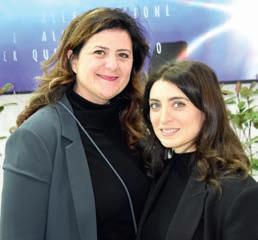
Fish farmers (and shers) can group together into producer organisations (PO) under the EU’s common organisation of the markets regulation. Aquaculture POs can take di erent legal forms including associations, cooperatives, or commercial organisations in which aquaculture producers are shareholders. Fish farmers are often small family-owned SMEs which, by joining together, have greater bargaining power with respect to sh buyers who are often better organised.
Membership of a PO thus gives improved market access through production planning, price stabilisation, communication and promotion, as well as marketing initiatives such as establishing quality labels. POs also supply members with technical assistance to improve product quality or production e ciency. ey also contribute to the sustainability of aquaculture operations by monitoring the environmental impact of aquaculture operations, implementing measures to reduce carbon footprint, and promoting best practices for sh health and welfare. ere are thus good reasons for establishing a new PO or joining an existing one.
In the EU there are there 37 aquaculture POs of which 14 are in Italy. Among them is Rome-based Del Pesce, which today is made up of six companies in Sicily and on the west coast of the Italian mainland. In addition, it collaborates closely with a hatchery, L’avannotteria on Sicily. Since 1997 the organisation has been dedicated to the production of seabass, seabream, and meagre in Italy. As a PO Del Pesce has most recently been involved with projects that help its members reduce their energy costs which have ballooned as a result of the war in Ukraine, the sanctions on Russia, and the high level of in ation. ese energy-saving projects include the installation of photovoltaic panels at the main farm sites and at the logistics and management centre. ese initiatives are among a number of measures that the organisation has included in its rst sustainability report to be published in 2023. e installation of photovoltaic panels will continue in the other member companies.
In addition to reducing energy consumption, the organisation is also recycling big bags (often used for feed) and the nets that are used on the sea cages to hold the sh. As the nets wear out they
are recycled into a plastic material that can then be used as a feedstu in other manufacturing processes. In Del Pesce’s case the material is used by the automobile industry. e commitment to sustainability also encompasses the welfare of the sta who are given training courses in the use of software, the Microsoft o ce package for example, to improve their skills and make them more productive, says Ludovica Lococo, who is responsible for the organisation’s digital communication. We o er voluntary training in both hard skills and
soft skills, she adds, in addition to the mandatory training that they receive. Federica Trepiccione, who assists senior management in the organisation, points out that the organisation collaborates with the association for people with disabilities and that almost a quarter of the employees are women to maintain a degree of diversity in the workforce.
Production from the group companies amounts to some 4,000 tonnes a year of the three species, seabass, seabream, and meagre. Nine-tenths of the production is
sold to supermarkets within Italy and the company has a policy of selling the sh in the region where it is farmed. e regions where the organisation has production facilities are Lazio, Liguria, Tuscany, and Sicily. Fish from Follonica, for example, a group company in Piombino, Tuscany, is sold primarily in Tuscany. is ensures that the sold product is very fresh which is one of the ways Italian farmed sh competes with cheaper imports from other Mediterranean countries. e other selling point is quality. Production facilities are often certi ed antibiotic free and conform to the GLOBAL.G.A.P. standard. e juveniles are obtained from the hatchery, L’avannotteria, on Sicily and are on-grown in cages for about 24 months. At harvest the sh are removed from the cages and are stored in a mixture of ice and water. ey are transported to the production facility to be checked, sorted by weight, and are then packaged in polystyrene boxes on ice for immediate distribution. All the necessary tracking and tracing information is supplied to the customer. From the time of harvest the integrity of the cold chain is maintained and thanks to mainly regional
distribution, Del Pesce can guarantee its customers that the sh is of the highest quality.




e PO is responsible for the sales and distribution of the sh from its member companies. Currently, all the sh is sold fresh on ice in polystyrene boxes, but Ms Lococo says that trials on valueadded products like llets and burgers are underway. e PO has subcontracted the sh processing to another company as it does not have its own facilities.
For the member companies there are distinct advantages to being

part of a PO. e PO takes over the sales and marketing of the production. It can also help the companies improve their production standards so that the product irrespective of which farm it comes from is of a uniformly high quality. e PO monitors the entire supply chain to ensure the process functions smoothly at each stage. And because it represents 4,000 tonnes of sh it carries a certain amount of weight when negotiating with customers. Often, however, the supermarkets will ask for sh from a speci c company in the group. And most of the sh, 80, is sold under private label. e PO is thinking of developing its own label, says Ms Trepiccione, but it is a slow
process. A label that certi es the Italian origins of the sh may blunt the inroads cheaper sh is making on the Italian market. e PO is interested in a label developed in collaboration with the ministry of agriculture that highlights that the sh is made in Italy from birth to sale to the end consumer. Educating Italian consumers about the bene ts of locally produced sh (freshness and fewer carbon emissions from transport) is the way forward, according to Ms Lococo. Improving the quality even further by using high quality feeds and high production standards should also help persuade Italian consumers to look not only at the price when shopping for sh.
Via Enrico Fermi 7 00012 Guidonia Montecelio (RM) Italy
Tel.: +39 077 4351435 info@gruppodelpesce.com gruppodelpesce.com
Senior management assistant: Federica Trepiccione
Digital communications: Ludovica Lococo
Activity: Farmed fish production and sale

Products: Seabass, seabream, meagre

Volumes: ca. 4,000 tonnes
Markets: Italy
Customers: Supermarkets
Production sites: Lazio, Liguria, Tuscany, and Sicily



Reducing plastic pollution in the Mediterranean Sea.
A concern about marine pollution from polystyrene has triggered the creation of a system that replaces polystyrene boxes in Italy with reusable polypropylene ones. Equipped with an RFID chip, the new boxes can also be tracked electronically.
Campania Plastica, an Italian manufacturer of disposable and recoverable plastic containers (products with second-life, recyclable raw material) in the fruit and vegetable sector for storage and transport, was founded by Dante Mele in 1987. In 2003 he created the DuWo sh box system, as the world became more aware of the dangers of climate change and of marine pollution, but the Italian seafood supply chain was not yet ready to switch from cheap disposable product made of polystyrene packaging to reusable and more expensive plastic boxes, so the project was shelved.
In 2019 Dante Mele was contacted by Paolo Baldoni who had equipped a small boat to clean the ports of polystyrene and other waste oating in the sea. Baldoni collaborated with CNR of Ancona (a research institute). e problem facing Mr Baldoni was that he could remove the polystyrene from the water, but as long as people kept putting it back all his work was in vain. Hearing this, Mr Mele understood that it was the right moment to relaunch his old project. He started visiting the shing ports of San Benedetto del Tronto, Ancona and other players
in the sh supply chain in Italy, to speak with the shermen to understand how the polystyrene boxes were used. He discovered that the shermen were aware of the problems with polystyrene and were willing to consider new approaches. is interaction also revealed the virtues and shortcomings of his sh boxes and prompted changes to bring the packaging in line with current times. e polymer used is polypropylene (PP05) a robust and inert material suitable for food preservation and reusable several times. It can be washed and sanitized repeatedly without weakening the structure.
Mr. Mele’s main aim was not just to sell the packaging, but to develop a solution that would help remove polystyrene from the sea. He created the fourth generation, returnable, reusable, long-lasting and recyclable DuWo packaging, with an embedded RFID chip. His collaboration with Professor Vincenzo Peretti of the University of Naples Federico II led him to sign a memorandum of understanding between the university and DuWO. e chip allows the box and its contents to be traced at any time and provides greater food safety and rigorous certainty of sanitization after its use and reuse, as well as control of the recovery of the raw material at the end of the box’s
life. e system was christened DuWo and once the boxes were ready, the next challenge was the cleaning system, the infrastructure for which had to be created in the ports. Mr. Mele designed a cleaning machine that would wash the boxes with hot water to kill any bacteria. But food safety could only be guaranteed with a HACCP system in place and the assurance that all health checks had been respected.
e solution was to design a software for the cleaning machines that calls for the workers to go through the tunnel where the chip is read, so the chip can guarantee that the box is clean. e machine is a closed-loop cleaning system so that part of the water utilized to clean the boxes can be recovered, treated, and reused for other
cleaning purposes, resulting in a signi cant water saving. Boxes can be washed until the end of their lives: some of the rst boxes, which were delivered 12 years ago, are still used, says Mr Mele.

Although today both large-scale retailers and wholesalers, who are very sensitive to environmental protection, are organizing themselves to use the DuWo system (tracking from sea to table), convincing all the links in the supply chain of the merits of the boxes was an uphill task. Fishermen, ports, restaurants, and shmongers are generally happy to use the crates, as they eliminate any
bad smells and waste, there is no waste, and they do not have to regularly buy polystyrene containers.
e wholesalers were more reluctant, but they play a key role in the success of this project, as it involves collecting and storing the boxes, until they are recovered, for their reuse. Despite this, Mr Mele is looking towards international expansion. e software was developed in several Mediterranean languages so that the boxes and washing machines can be used in many Mediterranean countries. Since the ambition is to reduce the use of polystyrene, Mr. Mele is willing to donate the DuWo system to all plastic box manufacturers, assisting them to make a small change to their molding system to create boxes that incorporate a chip he will supply. is would create a uniform traceability system across the Mediterranean.
DuWo boxes (30 x 50 x 11 cm) empty, save more than 50 of the space of conventional polystyrene boxes. ey can be equipped with an ice bucket cover to keep sh fresh and improve conservation.
e cover includes a barrier box to collect meltwater, so it doesn’t contaminate the sh. is solution makes the use of a polyethylene sheet between sh and ice super uous. is sheet often ends up in the sea adding to the pollution. e box is available in four models. In Italy, boxes are of the same colour blue, that is immediately recognizable as belonging to the DuWo system. e box model is identi ed by the chip.

Since 2022 around 100,000 crates have been delivered in Italy (they replace 100,000 polystyrene boxes a day!). In small marinas such as Genoa, Viareggio, Cetara, and northern Sardinia (Castelsardo, Porto Torres), the sh market of Ancona, and in other towns such as Salerno and Cilento, Giulianova, Pescara, Ortona, Mola di Bari, many sh operators are waiting for European funds to invest in the DuWo system. Chioggia, another important Adriatic port with a huge problem of pollution of polystyrene boxes, wants to switch to the DuWo system. DuWo boxes pay for themselves

after ve to ten uses and can be used at least 1,500 times. So, most customers buy the boxes even if rental is possible. e DuWo boxes o er another advantage as the size allows for convenient use in all areas of the supply chain, from wholesaler to retail, shmonger, sh market and even restaurant (from sea to table). is means there is less need to handle the sh which preserves its quality.
All these factors can convince the links in the supply chain about the bene ts of DuWo boxes, but we need a cultural change regarding responsibility towards the sea, says Mr Mele. People need to
Via Salice 14 84012 Angri (SA) Italy
Tel.: +39 081 949586
Toll-free number: 800 063500 (Only in Italy) inf@duwo.it www.duwo.it
understand the value of switching from single-use polystyrene, so dangerous for our seas, to a reusable solution that optimises the raw material.
A DuWo box has a 10 year lifespan and they are guaranteed for the rst 2 years with a replacement from DuWo at no cost. e system includes a transport network to recover the boxes and deliver them to a cleaning station. While the DuWo system was designed with the sh industry in mind, Mr Mele in considering creating di erent boxes models to expand this project to other sectors. ese reusable and recyclable boxes can help the world.
Owners: Mr Dante Mele
Activity: Supply of polypropylene
fish boxes and boxes washing machines
Box dimensions: 30 x 50 x 11 cm
Weight: 700 g
Traceable: Yes, with RFID chip
Models: Four (open, closed, draining, and with barrier)
Markets: Italy
The Friuli-Venezia Giulia FLAG helps its members diversify their incomes
Members of the Friuli-Venezia Giulia FLAG including fishing associations and municipalities are devising and implementing projects that aim to increase economic activity in the communities in which they live.
Fisheries Local Action Groups (FLAGs) are community-led organizations that aim to support the sustainable development of sheries and coastal areas. ese groups are funded by the European Union and operate in coastal communities across Europe. FLAGs work to promote economic growth, social well-being, and environmental sustainability in coastal areas. ey do this by bringing together shermen, local authorities, NGOs, and other stakeholders to develop strategies for improving the shing industry and supporting the local economy.
One of the main goals of FLAGs is to support the diversi cation of economic activities in coastal communities. is can include initiatives such as developing local tourism, promoting traditional crafts and products, and supporting the development of new industries. By diversifying the local economy, FLAGs aim to reduce the dependence of coastal communities on shing as the sole source of income. Another important goal of FLAGs is to support the sustainable use of marine resources. is involves promoting sustainable shing practices, protecting marine habitats, and supporting the development of sustainable aquaculture. By promoting sustainable practices, FLAGs aim to ensure the long-term viability of the shing
industry and the protection of the marine environment.
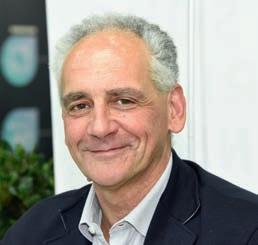
With over 50 FLAGs Italy has been the most successful country in the EU at using the support available for community led local development. In the Friuli-Venezia Giulia region in north-eastern Italy the coastal area is home to shing communities, mainly small-scale shers active in the sea and in the lagoon as well as mollusc farmers cultivating mussels and clams.
e FLAG, which comprises three municipalities, shing cooperative associations, trade unions and other stakeholders, has helped shers diversify their incomes, add more value to their products, and make the towns represented more attractive for tourists in the face of declining revenues from shing. Giovanni Dean, who represents the Confederation of cooperatives is one of the managers of the FLAG. He assists members of the FLAG, primarily shers, develop projects that will supplement their income.
Robi Zentilin has been shing for almost 40 years targeting molluscs including fasolari in the sea with a dredger, his main source of income, and using a smaller boat to catch sh in the lagoon with a gill net. About a decade ago catches of shell sh started to decline perhaps because of
climate change. is has resulted in a decline in the pro tability of dredger shing, he says. Smallscale shing and the lagoon shing do not bring much sh—the most commercially important product is cuttle sh which is caught mainly in spring—so today tourism, an activity he and his wife Joy started 6-7 years ago, has become the biggest income generator. e couple has designed and implemented three FLAG-supported projects that enable them to o er services to tourists. e rst project was to adapt his boat for touring and to modify his home. is allowed him to take tourists on trips in the lagoon and then bring them back home where they could get
a high quality meal cooked by Joy. e second project completed the work on the house including an upgrade to the kitchen and investments in garden furniture, while the third was an investment in bicycles and the the creation of an economic network with a connected bed and breakfast and a travel agency.
e FLAG helps the shers with these projects, says Mr Dean, explaining the philosophy behind the projects and preparing the necessary documentation. In Mr. Zentilin’s case, a new law allows him to host up to 10 people in his home without being a restaurant. Entertain more than that and di erent regulations kick in
making the enterprise more complicated and expensive. e boat too may not sail with more than 12 people even if it has the capacity— Mr Zentilin’s boat in fact cannot hold more than 7-8 people. e boat trip o ers tourists the opportunity to swim, sh, take photographs, have a picnic provided by Joy Zentilin , or just enjoy being on the water. e nature of tourism has changed, says Mr Dean. Tourists used to come for a month and spend most of that time on the beach. Now they come for a few days but expect to be active; they want to cycle, walk, and enjoy an experience. ere is demand for such services, but the infrastructure must be created, and the FLAG helps to do this.
e tourism activities have increased over the years with tourists arriving from several European countries. It is Joy Zentilin who is responsible for the marketing of their services for which she uses Instagram, email, and a newsletter. We have a new website (www. aliceseconda.it) with two activities, she says, pesca tourism which is the boat trip with my husband, and ititourism which is the restaurant. And our next project with the FLAG will be to establish a kitchen in the garden for barbecuing, she adds. She is the brains behind our enterprise, says her husband, and I provide the brawn! For the tourists the attraction is that they get an experience, says Mr Dean, they brie y get to exchange their lives with that of a sher. Doing this is not every sher’s cup of tea, he adds, as it calls for skills with language, interpersonal skills, an ability to talk about oneself and one’s work, and an interest in other cultures.
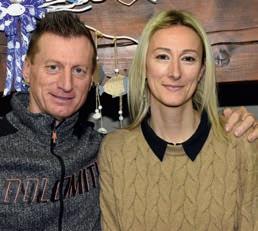
Further east, towards Trieste, another project supports a
laboratory cum restaurant that creates and tests value-added products from sh and shell sh. In the town of Grado, the local PO opened a shop and a restaurant on the quay where the sh is landed. Called Zero Miglia (Zero Miles) after the distance the sh has to travel, the shop and the restaurant sell sh that is as fresh as that sold at the auction. e restaurant adds signi cant value to the catch and compensates for the gradual decline in catches that the shers experience. With the FLAG’s support, the PO also converted a couple of unused rooms into a place where visitors could stay. e pro ts from the restaurant, the shop, and from renting out the rooms is returned to the shers in the form of reductions in the subscription they pay to be members of the PO. A new museum of shing will open in Grado this summer. is too is a project supported by the FLAG that bene ts the Grado municipality. e museum will o er tourists something to do when bad weather prevents outdoor activities. It will be highly interactive with audio and video material about shers and their lives and with many artefacts donated by shers. e plan is to invite retired shers to tell their stories to the guests or to take them on a tour of the port. e building housing the museum belongs to the municipality while the FLAG supported the remodelling of the interior. e museum will not be about sh alone, but about life in the lagoon—the people, the houses, and the practices.
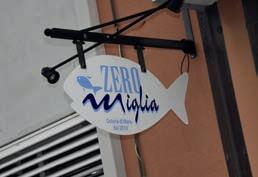
Another project, this one with the PO of Marano Lagunare, seeks to popularise cockles, a species that lacks the reputation
of clams and other bivalves. e town is Friuli-Venezia Giulia’s most important shing town with about 60 of the region’s shers. As resources of the more popular species declined the thought was that cockles could perhaps replace them. e PO, a member of the FLAG, together with the university of Udine found that cockles had a sea-like taste and a
short shelf life. Shell sh depuration removes health hazards and the FLAG had funds to invest in a puri cation plant. e PO could then promote the cockles to tourists (and residents) as a fresh local product (making the short shelf life an asset). Visitors to the area could then add sampling cockles to other local experiences like exploring by bicycle, sailing on
the lagoon, and swimming. For Mr Dean, the point is to o er tourists di erent activities that will keep them engaged with the area for a few days.
Marano Lagunare also has a sh auction where the sh caught by the local shers is sold. e FLAG is trying to strengthen the PO by helping it build the infrastructure for the sales of all the shermen’s catches. Some 70 enterprises or 100 shers belong to the PO in Marano, of which about 30 sh with trawlers and dredgers and the remainder are small-scale shers. Currently each sher sells his catch as an individual, which places the big buyers in a position of strength. If the PO takes over the sales the relationship between buyer and seller would be more balanced. e PO will dictate the price basing it on the quality of the sh
and if the buyers are unwilling to pay the price, the sh will be sold in Venice or Trieste. e system was implemented in Grado some years ago and has proved to be successful, says Mr Dean, which is why we want to introduce it in Marano. e PO also plans to build a processing plant with support from the FLAG. e plant will add value to the sh compensating for smaller catches.

In another project, this time with the Marano municipality, the FLAG supported the installation of water and electricity points along the pier. Altogether, some 15 points were installed in four places. Vessels can now dock and recharge their batteries

and ll up on water. e idea is to make the port more welcoming for tourists and to try and encourage them to stay. During the summer tourists use Marano as a parking space for cars, and then continue with public transport to the beaches. By making the port more visitor friendly the FLAG hopes that visitors will be persuaded to stay longer in Marano, avail of some of the services o ered, and contribute to the town’s economy.
A project by the municipality of
established points where vessels could connect to electricity and water supplies. This kind of infrastructure is necessary to persuade visitors to spend time in the town.
FLAGs can play a useful role in a community not only by diversifying sources of income for its members, but by encouraging sustainability, growth, and the creation of networks that can make small coastal communities more dynamic and economically viable.
Piazza della Borsa 14 34121 Trieste Italy
FLAG Activity Manager: Mr Giovanni Dean
Tel.: +39 0432 600546
dean.g@confcooperative.it
Remotely Operated Vehicles (ROVs) have already been used extensively in various marine industries, including offshore oil and gas, marine science, and military applications. However, their use in the marine aquaculture industry is gaining momentum, and for good reasons.
Aquaculture is the fastestgrowing globally food sector and, as the demand for seafood continues to rise, it needs sustainable and e cient methods of production.
However, marine aquaculture faces several challenges as environmental impacts, disease outbreaks and high operational costs. Here ROVs present a valuable tool for addressing these challenges and for improving the e ciency and sustainability of marine aquaculture operations.
One of the main applications of ROVs in aquaculture is for underwater inspections and maintenance. ROVs equipped with cameras and sensors can provide a detailed view of the underwater environment, allowing operators to identify and assess any issues such as equipment damage, fouling, or disease outbreaks. is enables early detection and rapid response to potential problems, minimizing the impact on the ecosystem and reducing the risk of economic losses.
ROVs can also be used for feeding and monitoring sh populations. Aquaculture operators can remotely control ROVs, equipped with speci c systems, to deliver
precise amounts of food to sh populations. is ensures that the sh is adequately fed, reduces the risk of disease outbreaks and promotes healthy growth. Additionally, ROVs can monitor sh behaviour, health, and growth rates, providing valuable data for optimizing feeding regimes and production strategies. Another promising application of ROVs in aquaculture is for environmental monitoring. ROVs can collect water samples, measure environmental parameters such as temperature and dissolved oxygen, and monitor the impact of aquaculture operations on the surrounding ecosystem. is information can help operators make informed decisions about production practices and ensure that their operations are sustainable and environmentally responsible.
e Sea Opportunities is an Italian company primarily active in R&D, engineering, production of remotely operated subsea and surface vehicles, and providing services that go with them for the aquaculture and other maritime industries. e company was established in 2017. e rst model of its ROV can reach a depth of 300 m and is targeted at the aquaculture sector as well as the o shore energy industry,
says Alessio Canalini, the founder of the company. is ROV can be equipped with di erent instruments (sensors, robotic arms etc.), rented or bought, depending on the task at hand. ey perform important functions, for example, a sensor that measures depth can keep the vehicle at a uniform height above the seabed as it travels in the water, or a multi-parameter probe can sample the water for temperature, salinity, oxygen content, acidity or other criteria. e vehicle can perform di erent inspections as it is equipped with video camera which can lm in di erent resolutions as well as a 3D imaging
sensor. ese technologies can be used to create an image of the seabed which is very useful when making, for example, a pipeline survey. Other sensors can also be installed, such as a magnetometer (metal detector) to determine, for example, where a pipeline may be buried. ese instruments indicate the stratigraphy of the seabed and identify buried pipelines, bre optic cables or other objects. e company has entered into a partnership with an Australian company that manufactures robotic arms with di erent degrees of mobility than can be attached to the ROV allowing it to perform more complex tasks.

ese arms are electric ensuring a low environmental impact without any pollution of the sea. Most of the companies producing sensors are based outside Italy, says Dr Canalini. Some Italian universities have projects to develop sensors, but commercial production has not started yet. Getting the sensors from outside Italy means that in the case of problems a technician may have to be brought in from the supplier which is likely to be more timeconsuming and expensive than getting somebody from Italy. at is why Dr Canalini tries to source as many of the ROV’s components as possible from within Italy.
e Sea Opportunities does not just produce underwater ROVs but also Unmanned Surface Vessels (USVs), that can be used to transport an ROV to a destination, such as a sh farm, 2-3 miles o shore. Since the vessel is unmanned and runs on batteries, using it to transport the ROV reduces costs. Both the USV and the ROV can be operated from a control panel which could be placed in a room, van, or container at the coast anywhere
in the world. If the object to be monitored is further out to sea, for example an oil rig or a wind turbine, then the USV needs to be transported to the destination by a mother vessel. In this case, the control panel will be onboard the vessel as the USV may not be further than one mile from the mother ship, says Dr Canalini.
To be controlled by the operator, the ROV is connected to the USV with a cable which transmits data and power. e USV can also be equipped with a rechargeable power station for a drone that can be used for monitoring activity on the sh farm from the air. us, if desired, the farm can be monitored from underwater, from the surface, and from the air all at once.
e equipment is designed to be as environmentally friendly as possible. Our idea was to distinguish ourselves from other manufacturers on this point, recounts Dr Canalini, however, while much of the material used is recyclable, we have not reached 100. For example, the cable connecting the ROV to the USV has a recyclable rubber exterior and a core made from a natural bre.
e chassis of the vehicle is made from iron and steel or aluminium,
but not breglass. e only part of the vessel that uses plastic is the buoys but they are recyclable too. From the outset the power source was planned to be renewable.
e ROV, in fact, does not have batteries but is powered from the surface vessel when at sea or from the electricity grid when it is being operated from land. Ultimately, the plan is to use photovoltaic panels in conjunction with lithium batteries. But Dr Canalini also follows developments in the use of hydrogen as he considers it the future of the energy sector.
In the oil and gas industry ROVs are used at depths which a diver cannot reach. In the aquaculture sector the depths are not as great, but as ROVs become more versatile they are likely to gradually take over more tasks that divers currently perform to save costs and reduce safety risks. As a diver himself, Dr Canalini feels divers could become e ective ROV operators as they know the situation in the sea. When a diver controls the ROV from the surface using the camera it is as if he were in the water himself executing the task being performed by the ROV.
e Sea Opportunities has sold its products so far mainly in Italy. In 2020 it participated in the O shore Energy exhibition
in Amsterdam where companies from the UK, Netherlands, and Portugal showed interest in the services Dr Canalini has to o er. More recently, he says, he has been in touch with an oshore wind farm in China. If the energy crisis continues, Dr Canalini envisages that 70-80 of the demand for e Sea Opportunities’ products and services will come from the energy sector. e company intends to develop a smaller ROV but with more powerful thrusters that can operate at 200 m depth. He mentions a wind farm planned o Italy’s Tyrrhenian coast where the depth is 400-500 m so the turbines will be oating rather than xed. Floating photovoltaic systems are also being considered, he says, and all these o shore systems will call for more monitoring and more maintenance which is where our products can play a role. e energy crisis that has hit industry with soaring energy bills has in fact bene ted e Sea Opportunities as governments scramble to build renewable energy infrastructure.
e use of ROVs in marine aquaculture and other sectors is a growing trend with signi cant potential to improve e ciency, sustainability, and environmental performance. As technology continues to advance and costs decrease, ROVs will be deployed on a wider scale in all kinds of o shore industries including aquaculture.
Via Lombardia, 21/C 61122 Pesaro (PU) Italy,
Tel. lab.: +39 0721 162 6897
Lab. mobile: +39 393 853 4979 info@theseaopportunities.com www.theseaopportunities.com
CEO: Alessio Canalini
Activities: R&D, Design and production of remotely operated vehicles

Products: ROVs, USVs
Sectors of interest: Offshore industries including aquaculture and energy
Marine invasive species are a threat to seas and oceans everywhere and nowhere more so than in the Mediterranean, where heavy shipping traffic and passages to the Atlantic and the Red Sea have contributed to the challenge. Keeping an eye on invasive species to observe their introduction and distribution calls for collaboration between scientists, fishers, fisheries administrators, NGOs, and with others involved with the sea, such as recreational divers.
Ernesto Azzurro, an ichthyologist and senior researcher at the Italian scienti c institute, CNR Ancona, studies the ecology and distribution of invasive and non-indigenous species looking at both theoretical and practical aspects. He collaborates with stakeholders such as shers and divers around the Mediterranean to monitor invasions and to this end has designed simple questionnaires for them to ll out. e information provided can be used by scientists or other stakeholders.
e methodology, often reported as the Local Ecological Knowledge (LEK) protocol, is simple but it works well at the regional level. e shers responding are mainly small-scale, but they provide a lot of useful information.
e method has drawn the interest of several projects and of FAO, which has adopted the questionnaire to be used in the di erent Mediterranean subregions.
e LEK protocol is also used to monitor sh species that are considered indicators of climate change. ese species change their distribution in response, for example, to warming water, and

give thereby an idea of changes in the coastal area. Dr Azzurro speci es that thermophilic species that colonise cooler water in response to warming cannot be considered as invasive nor nonindigenous species but are native range-expanding species. By de nition, invasive or non-indigenous species are those that have been translocated through human intervention. However, it is not always possible to know whether a non-native species has moved to a certain area of its own volition or through human agency.
e interviewees selected were generally experienced shers, divers, or recreational anglers with more than 10 years of activity in the area where the interview was made. ey had a good knowledge of local sheries and were skilled in species identi cation. e questionnaire asked for precise information about the sher, his gear, the abundance of his catch over the last decades (as represented by a number from 0 to 5, where 0=absent, 5=dominant) of the species concerned. It also asked for information on occasional catches of species never seen before. e LEK protocol allows reconstructing the chronology of an invasion on a large geographical scale. If, for example, it becomes apparent from the questionnaire that
the sher started shing a species occasionally a few years ago that has now become abundant, it would suggest an invasive species. At the same time it can also provide information on rapid declines in catches of a species.
e questionnaires are distributed all around the Mediterranean to give a comprehensive insight into developments in the water in terms of both invasive species and climate change.
Usually when a researcher comes across a species in an area where
it has not been seen before, they will publish a brief paper to announce the nding. is typically will be how the data from the questionnaires will end up in the literature. Once the information gathered from the questionnaires is available in the literature IT will be included in the ORMEF (Occurrence Records of Mediterranean Exotic Fishes) geoportal (https://ormef.eu/). is is a free, online searchable database about Mediterranean exotic shes. It provides updated geo-referenced information for scientists, conservationists, and policy makers, disseminating specialists’ knowledge and experience to a broad audience.
e database is populated with validated data from scienti c literature going back to the end of the 18th century. e term exotic in the name of the database is deliberate since it includes not only non-indigenous species but also species that have probably
arrived in the Mediterranean from the Atlantic through the strait of Gibraltar without human intervention. Some invasive species can become a resource that shers catch and sell. In areas where the invasion started, people learn to use the sh. However, this is not
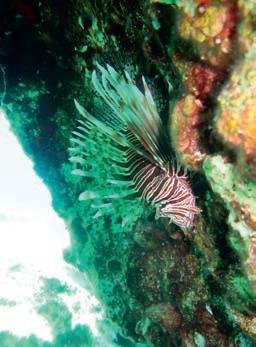
always the case as the appearance, taste, and texture of the sh as well as the culture of consumption in uence buyers. e invasive blue crab starts to be well-liked in Italy, whereas rabbit sh (Siganus spp.), which has begun to invade the waters around Sicily, is not considered a good sh to eat in Italy, but in other parts of the Mediterranean it is popular. In fact, says Dr Azzurro, today most of the commercially caught species in the eastern Mediterranean are invasive.
e ORMEF Geoportal, allows users to check and visualize the distribution of more than 200 sh species, but the system also visualises the expansion of the invasion in time and space by allowing the user to play an animation. e animation shows policymakers when and where a species arrived in the Mediterranean and how it is expanding. e data can also be used to calculate trends, make forecasts and to feed species distribution models. is ability is useful to model species distribution in the present scenario but also in climate change scenarios in 2050 or 2100. e data can also be used to provide a risk assessment of future invasions, which is very useful for identifying future threats to marine protected areas. Knowledge of invasive species, while useful, does not suggest how they should be dealt with. e reason is that there is little to be done. Invasive species cannot be eradicated and since many are expanding their territory naturally without human intervention tightening rules on shipping will make no di erence. What we can do, feels Dr Azzurro, is to collaborate with the sheries system and civil society to work on adaptation—using the invasive species
as a resource to be consumed or investigating it for the presence of useful biomolecules or other valuable components.

is attempts to make the best of a bad job. Biological invasions are the second most important threat to biodiversity after habitat destruction. e invaders compete with the native species for food and habitat and this is on top of the stresses caused by climate change. In the short term the appearance of invasive species may increase biodiversity at the local level but in the long term biodiversity decreases because of the likelihood that native species are outcompeted and become extinct. Salerna (Sarpa salpa), for example, has disappeared from the eastern Mediterranean due to warming water but, in addition, it su ers from competition with tropical herbivores, such as rabbit sh. is process started in the east which is warmer and more invaded by rabbit sh, but is spreading to the central and western parts of the Mediterranean. is development should come as no surprise as the Mediterranean is one of the hotspots of climate change, warming at three times the global average and is, at the same time, the most invaded sea in the world. Maintaining healthy stocks of native species is the only way to ensure resilience in the face of these threats.
For more information, contact:
Dr Ernesto Azzurro National Research Council. Institute of Biological Resources and Marine Biotechnologies (CNR-IRBIM) AnconaMicroalgae are gaining in importance for aquaculture




















Microalgae cultures have been an established part of modern aquaculture for more than four decades. Due to their high nutritional value, photoautotrophic strains of microalgae play an important role in the cultivation of marine fish larvae as well as in the early stages of development of other aquatic organisms. The demand for microalgae is already considerable and could increase further, because the cell biomass also has the potential to replace a proportion of fishmeal.
Almost 35.1 million tonnes of algae and aquatic plants with a value of USD 16.5 billion were produced in aquaculture worldwide in the year 2020. However, this was almost all macroalgae such as kelp, wakame and gracilaria, which are almost exclusively used to manufacture

agar and carrageenan. e production of microalgae, microscopically small organisms that occur in both fresh and salt water and that oat freely in the water or grow benthically, is a signi cantly smaller industry in comparison. But they do have enormous biological signi cance in aquatic

ecosystems, as they are located right at the bottom of aquatic food chains and therefore represent the basis for zooplankton as well as the di erent stages of development of other life forms in the water. Nauplii and the larvae of shell sh, bristle worms, snails, crustaceans, echinoderms and



also some sh larvae – even those of species which later become carnivorous – can rely on microalgae to feed and develop in a healthy way, either permanently or temporarily during speci c stages of development. Anyone wishing to successfully cultivate young organisms to stock aquaculture



farms, such as shrimp, oysters or sh, therefore cannot really get around cultivating microalgae for feeding purposes in the hatcheries. is explains why, despite the comparably small quantities in which they are produced, microalgae are almost indispensable and play a large part in the success of global aquaculture.
In recent decades, several hundred species of microalgae have been tested for their suitability for aquaculture purposes, but only about twenty are used widely. e requirements are high, as the algae must meet the nutritional needs of the bivalves, crustaceans or sh as well as being as easy as possible to cultivate. First, what is important is rapid growth rates, suitability for mass cultures and sensitivity to light and temperature uctuations. Second, it is also about nutritional composition, taste, digestibility or toxins that may be present. In addition, the size of the algae must be suitable for the width of the mouth and the consumption capacity of the target species. Generally, 1 to 15 μm for lter feeders and 10 to 100 μm for grazing species that graze the microalgae from hard structures is seen as suitable.
e explanation for the enormous value of the microalgae diet, which is practically indispensable for initial or permanent feeding in marine food chains, is obvious. As photoautotrophic organisms, they are able, in the presence of sunlight, to convert carbon dioxide into sugar compounds and other organic molecules that are important to life, including lipids with multiple unsaturated long-chain fatty acids (omega-3 type PUFAs such as EPA and DHA). With these ingredients, microalgae provide
the larvae of sh and those of other groups of species with a balanced nutritional pro le that meets their needs. ey promote the development of micro ora in the larval intestinal tract and have antibacterial properties that support the health of the sh larvae. Microalgae contain a variety of bioactive substances, from essential amino acids to vitamins and minerals, to pigments, some of which have antioxidant e ects. Depending on the species and age, however, the nutritional value of microalgae can vary signi cantly. e decisive factor for this is, in addition to age-related changes in the biochemical makeup, primarily the cell wall structures. In the logarithmic growth phase, when the number of algae cells in the culture increases very quickly, microalgae typically contain 30 to 40 protein, 10 to 20 lipids and 5 to 15 carbohydrate. As soon as the stationary phase has been reached, however, the proportion of carbohydrate can double at the expense of the protein.
e main application of microalgae is therefore in the area of nutrition, where the cells can be used in their whole form or in the form of certain cell fragments. An example of this is the yellow or red pigments (carotenoids) contained in some microalgae that are mixed into sh feed to give the sh an attractive colour, which makes many customers more willing to buy them. Natural carotenoid pigment from the Haematococcus pluvialis algae, for example, serves to colour salmon llets, the skin of the red porgy (Pagrus pagrus) or Litopenaeus vannamei shrimp an intense red. Salmon with algal biomass mixed into their feed were livelier, healthier and more active than conventionally fed sh. e taste and texture of their llets was said to be signi cantly
improved, which experts claim to be the result of the bromophenol, vitamins and minerals contained in the algae. Generally, microalgae are good sources for natural, highly bioavailable vitamins, the quantity of which can however vary signi cantly. e greatest deviations are shown for ascorbic acid (vitamin C), the concentration of which, depending on the species of algae, can vary over the course of the year by about 16 times (between 1 and 16 mg/g dry weight). For other substances such as niacin, thiamin, riboavin, pyridoxin, cobalamin or biotin, the extent of the uctuation is signi cantly lower, at two to four times. Algae are, after all, natural products, the composition of which is in uenced by a variety of internal and external factors that result in changes in their contents.
Globally there are thousands of hatcheries that grow microalgae strains in cultures to supply stock animals for aquaculture farms with nutritionally rich feed. e algae grow in special systems and
equipment, the design of which ranges from open ponds or tanks with or without ventilation, to bioreactors, which are very demanding in terms of their control technology and work in closed circuits. Algae production can be done in batches (batch culture) as well as in continuous permanent operation (steady-state cultures), which allows for algal biomass to be regularly extracted. If larger quantities of algae are required, outdoor basins or ponds are often used. is is relatively economical, but is also prone to challenges, because the cultures can be inhibited by adverse environmental impacts or contamination. For this reason, many hatcheries turn to closed photobioreactors instead, which are frequently designed in the form of ventilated vertical tubes or as at plates. Balloon bottles (10 to 20 l), polyethylene sacks (100 to 500 l) and plastic basins (1,000 to 5,000 l) are particularly popular for microalgae mass cultures. Such systems are productive, but also relatively expensive. e energy requirements alone for permanent lighting, ventilation and motion of the body of water with the algae result in signi cant costs.

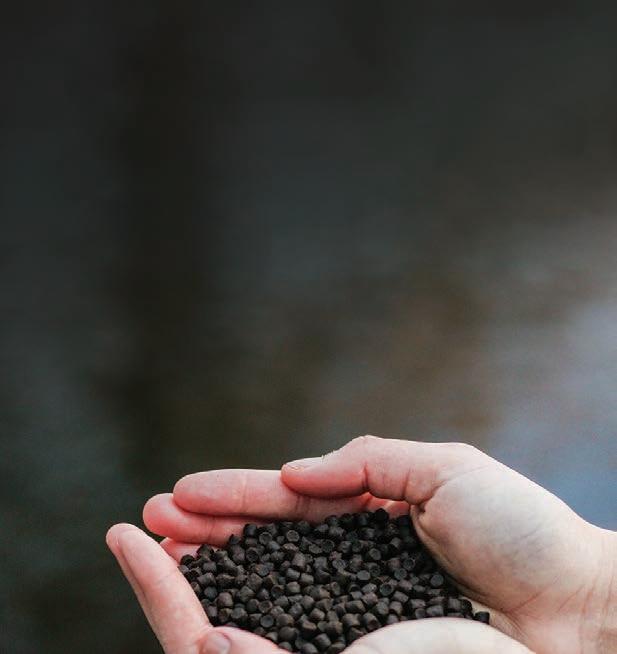

Depending on the size, hatcheries produce several hundred to a thousand litres of algal mass per day, whereby the cell densities in standard systems are usually between 105 to 107 algal cells/ml of water. e production costs usually vary between 50 and 200 USD/ kg of algal dry weight and can constitute 20 to 50 of the total operating costs of a hatchery. ere are, however, considerable economies of scale: the highest costs almost always occur in smaller hatcheries. As an alternative to cost-intensive algae production that requires light, researchers are currently intensively searching for microorganisms such as bacteria or yeasts that can grow heterotrophically without light in “fermenters”. Lipid emulsions are also being considered as economical alternatives to microalgae, although they have a lower nutritional value than microalgae mixtures. Full equivalent replacements for microalgae have still not been found, so microbial biomass is in practice always used as part of a mixed feed.

Microalgae are required in aquaculture to cultivate di erent groups of species. All development stages of mussels, for example, can use microalgae as their food source, because they are lter feeders. Every mussel hatchery therefore has su cient capacity for microalgae production. e larvae of abalones (gastropods, snails) and some sea urchin species (Echinoidea) do not need any microalgae during their plankton phase, as they are still nourished by internal reserves of yolk. As soon as they leave the plankton stage and transition to life on the sea oor, however, they need benthic microalgae as their
initial food. At least until they are large enough to feed on macroalgae. erefore, benthic diatoms such as Navicula, Nitzschia and Amphora algae are mass-cultivated for these species. e plankton larval stages of commercially important crustaceans, which primarily include penaeid shrimp, initially feed on microalgae, which are later replaced with living zooplankton.
For the larvae of some sh species, particularly from the marine environment, microalgae are practically indispensable as an initial and supplemental feed to ensure that they receive balanced nutrition. Only a few species, such as salmon and other salmonids, are able to immediately consume and digest dry feed diets immediately after exhausting their extensive reserves of yolk. In contrast to mussels, snails and crabs, however, only a few sh larvae consume microalgae as food directly, as they prefer live zooplankton, the motion activity of which stimulates their predator re ex. Since the 1960s, almost all sh hatcheries therefore use rotifers (usually Brachionus species) and brine shrimp nauplii (Artemia sp.) as feed for the sh larvae, which resemble their natural zooplanktonic live prey. e advantages of rotifers and Artemia are their easy availability and simple culture in high stocking densities. Rotifers also have rapid reproduction rates in the cultures. e disadvantage of both groups of species is their sub-optimal nutritional pro le, which can trigger nutritional and developmental disorders in the fry. e lack of n-3 PUFAs has particularly serious consequences. In order to remedy this issue, rotifers and Artemia nauplii
are frequently fed on microalgae before being fed to sh larvae. e zooplankton organisms are, as it were, used as live transport vehicles to get the nutritious microalgae into the bodies of the sh larvae. is step, which improves the nutritional pro le of the live prey, is called enrichment. Fish larvae thus receive the extra portions of proteins, amino and fatty acids, vitamins, minerals and biologically active secondary plant materials that they need for their development.
What sounds simple is often somewhat tricky in practice, however, because enrichment depends on dosage and the correct timing, particularly for rotifers. It is important that sufcient algal food is available to them at all times. If the algae concentration in the water becomes too low, the number of rotifer eggs produced reduces and the culture yield then decreases. An important criterion for the density of the algal soup is the green colouring of the culture medium, the assessment of which requires a certain amount of experience. e only thing that is certain is that the density of microalgae is
not su cient if the culture water is too clear. e larvae of some tropical snappers and groupers are so small, however, that even Brachionus rotifers, which measure only 200-350 μm, are too large to use as an initial food. Such species are often fed with powdered food, sieved o spring (copepodite stages) of copepods. Others, such as the larvae of the Atlantic halibut, have very special nutritional needs and require diverse wild plankton as feed to prevent developmental disorders. ese zooplankton organisms are also often enriched with microalgae.
Although the production of microalgae lags well behind macroalgae in terms of quantity, their significance for global aquaculture is already considerable. For the moment, this is only in specialised areas such as stock production or the manufacture of pigments, but when success has actually been achieved in future in exploiting microalgal biomass for supplying protein to aquaculture farms, these tiny green cells will likely become even more indispensable.
Manfred KlinkhardtNorway exported fish and seafood of a value of 14.2 billion euro last year – 25% more than in 2021. More than 10 billion euro worth of salmon was exported for the first time ever. In total, Norway sold 2.9 million tonnes of seafood in 149 countries across the world. This corresponds to 40 million meals every day of the year.
The export value of sh and seafood from Norway was a considerable 2.9 billion euros higher in 2022 than in 2021. Nevertheless, at a time characterised by war in Europe, extremely high energy prices, high in ation and resulting reduced purchasing power, total exports fell by 5.3. Part of this decline is the result of a lower catch quota for cod as well as lower water temperatures in the sea, which has led to a lower number of salmon that are mature enough to be caught. At the same time, there has been a strong increase in prices for the most important sh species such as salmon, cod, mackerel, trout, pollock, and herring.
eir export value has doubled in the last seven years. For example, exports of Norwegian salmon grew in value over the last ten years by an average of 14 annually. Salmon remained the strongest species in 2022, with a 70 share of export value. It was followed by cod (8), mackerel (4), trout (3), herring (3) and mussels (1). “Norwegian sh and seafood are strongly positioned worldwide and were exported to 149 countries in 2022”, said Christian Chramer, the CEO of the Norwegian Seafood Council (NSC) since July 2022. “Norwegian salmon is popular worldwide, cod is strongly positioned in Europe,
Norwegian mackerel is dominant in Asia, bacalao is almost ‘sacred’ in markets such as Portugal and Brazil – and ever more consumers and cooks are discovering Norwegian shell sh.”
“However, we live in challenging times. Not just because of the war in Ukraine, which has led to the energy crisis and higher prices, as well as new transport routes and costs. e coronavirus pandemic will also continue to cause di culties for exports”, said Mr Chramer. ere are apparently a series of challenges for exports:
– When exporting salmon to China, every salmon must be packed in an individual bag due to Covid-19.
– Brexit has made exporting to the UK more di cult. Rather than free access to the market, exports come up against technical and veterinary regulations.
– Brazil is attempting to harmonise with the international rules, but this framework is not working in practice.
– When exported to Japan, Norwegian mackerel is subject to higher customs charges than mackerel from other countries.
Despite this, Norway set new records in 2022. “ is is the result
Christian Chramer: “Norwegian salmon is popular across the world, cod has a strong position in Europe, and Norwegian mackerel is dominant in Asia.”

of years of work to build up strong global demand for sh and seafood from Norway”, explains Kristin Pettersen, Country Director of the NSC for Germany. Norway is said to be one of, if not the only country with an organisation like the Norwegian Seafood Council, which works together with the industry to increase export value. us, a total of 40 million euro was invested in global activities in 2022 to increase knowledge
of seafood from Norway and demand for it.
In Germany, a TV campaign for salmon was run, among other measures. In uencer marketing brought Norwegian salmon to the barbecue, Friday was declared as herring day and during the season for cod from the Barents sea, one could participate in the life of a shery in Lotofen. All with the aim of making a positive
contribution to the Norwegian shing and aquaculture industry.

In 2022, Norway exported 1,255,851 tonnes of salmon, worth of 10 billion euro. e quantity fell by 2. e most important markets for the salmon were Poland, France, Germany and the USA. e USA accounted for the greatest increase in exports with 57 versus 2021. e volume increased to 66,000 tonnes, 22 more than the previous year.

e year 2022 brought record high prices for salmon llets as well as for fresh whole salmon. e opening up following the pandemic had a positive e ect on the demand for salmon in many markets. is increased demand, combined with a slight decline in the worldwide quantity of Atlantic salmon, is one of the key causes of the price increase. ere is also a higher level of processing.
A total of 162,600 tonnes of Norwegian salmon went to Germany, one of the most important markets for Salmo salar, in 2022. is approximately corresponds to the

level of the previous year. As food prices have increased more in Germany than in other markets, the rising prices have also had a negative e ect on household consumption of salmon. And this is despite the fact that the price for salmon has increased less than the prices for other proteins on the German market. According to an absolute comparison, salmon is an expensive source of protein. In ation and uncertainty about the future have meant that salmon now ends up on plates less often in Germany.
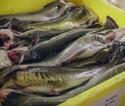
Fresh cod from Norway is known to many Germans as ‘skrei’. Following the 2022 skrei season, which ended in April, 50 percent of the population over 18 years of age knew that skrei comes from Norway, according to an investigation by the market research company Ipsos Tracker. In the past year, direct exports of these winter cod from Norway to Germany rose. Overall, the consumption of skrei in the winter months of January to April was 5,100 tonnes, which corresponds to the level of the previous year.
Norway recently exported 289,024 tonnes of herring of a value of 36 million euro. is corresponds to a decline in quantity of some 17 percent. Europe, especially German and Poland, makes up 28 percent of the export value of Norwegian herring. In order to stop the decline in the important herring market of Germany, renewed marketing activities for the Clupea harengus have been launched since 2022.
Norway has great ambitions for the future. e government of
The total quantity of exports was 5.3% lower than in 2021. A lower catch quota for cod (photo) and lower sea temperatures and therefore fewer salmon that were mature and ready for harvesting.
Norway exported 54,321 tonnes of fresh cod with a value of 251 million euro in the past year. at corresponds to an increase in value of 14 compared to 2021. e volume decreased due to a lower catch quota compared to the previous year. e markets for fresh cod are in Denmark and the Netherlands, both of which are however primarily transit countries for the sh. While the quantity of cod caught from the wild fell, fresh farmed cod rose from 1,300 to 3,800 tonnes.
e outlook for Norwegian cod cultivation is positive. By the year 2030, up to 50,000 tonnes of cultivated cod will be exported.
Salmon is a relatively expensive source of protein. That combined with uncertainty about the future meant less salmon was consumed in Germany in 2022.
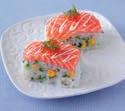
the country, as part of its export programme, has adopted the goal of increasing total exports excluding gas and oil by 50 percent by the year 2030. is requires an average annual growth in exports of 5.2 percent. “With an export value for sh and seafood that already makes up 22 of exports, this sector is important for reaching the overall goal”, says Kristin Pettersen.
Overall, the consumption of skrei in the winter months of January to April was 5,100 tonnes, which corresponds to the level of the previous year.
New products and species will make contribution to this in future. Already today, live bivalve molluscs are exported for a higher price than frozen goods. is trend should continue, according to the plans of the Norwegians. Live shell sh were also exported to Germany from Norway last year, mainly for catering establishments. Seaweeds from
Norway, which are now being intensively cultivated, have great potential. e NSC representative is certain that “a variety of di erent species from aquaculture,

Norway has a long history of policies to reduce the loss of nets at sea
such as farmed cod, will contribute to export growth”.

Plastic marine litter is not a new challenge, but one that has become increasingly serious all over the world. Although great attention has been given to marine litter, there is a broad consensus that the predominant proportion of marine litter is not really visible, as it has sunk beneath the surface. It is alarming, as plastic in the oceans will in time breakdown into very small fragments (micro- and nanoplastics) that pollute marine waters and marine life.
Abandoned, lost, or discarded shing gear creates twin problems. Not only does it add to the volume of these plastic particles in the water over time, but until it does, it “ghost shes”, catching and killing sh and other marine organisms.
Ghost nets can not only promote the spread of invasive alien
species and harmful microalgae by providing a micro-environment for them to travel to sites where they can cause habitat degradation—but nets can also accumulate more marine litter, that may lead to the smothering of benthic communities, entanglement of boats, loss of shing gear, and can generate other negative coastal socioeconomic impacts.
Lost gear can come from both professional and recreational shers, and from the sea-based aquaculture industry as well. It is very difcult even to estimate the scope of the problem, as no science-based knowledge exists on the actual amount of lost plastic shing gear.
By now the whole world is familiar with the problem of plastic pollution in marine waters and the impacts of ghost shing as well. Several information and awareness-raising campaigns are trying to draw attention to the issue, but they can only provide limited advice on how to eliminate or mitigate the problem. Clean-up campaigns are sometimes organized with the help of divers and
With the right incentives and infrastructure in place fishers will hopefully bring nets back for proper disposal or report their loss to prevent the death of marine animals.
volunteers, whose abilities to remove abandoned shing gear are limited to areas close to the shore and not deeper than 40 m. Professional and regularly organized clean-up campaigns, where vessels are used to retrieve lost shing gear, are rare as they are expensive and need planning and organization (e.g. to identify gear hubs where lost or abandoned shing gear tend to accumulate due to underwater currents, announce closures, secure proper vessels for the task etc.).
Norway has been working on the retrieval and reuse of lost shing gear for more than 40 years. is makes Norway ahead of most other countries in this respect. With a number of mechanisms established for gear retrieval and the mitigation of ghost shing covering the whole life cycle of gear, from production to nal deposition or recycling, Norway has taken a lead in the ght against this scourge. In Norway it is compulsory to mark shing equipment for owner identi cation. When a shing gear is lost, shers are obliged to report it within 24 hours to the coast guard. A clean-up is organized each year by the Norwegian Directorate of Fisheries. If the gear is found, it will be given back to the owner. If it was not reported, the owner will be ned and the gear con scated.
e regulation applies not only to shers, but relevant authorities are also entrusted to follow up on reported losses, impose penalties and implement yearly clean-ups. It also requires the involvement and cooperation of ports and port services to store and transport endof-life shing gear brought ashore.
To reduce the risk of ghost- shing for crab shers, for example, it is mandatory to use traps and pots for lobsters and common crabs that have an escape opening closed with a cotton rope, which is a biodegradable material. e shers are also legally obliged to mark the pots with an owner registration mark as well. ese are regulated under the “harvesting regulations” of the “regulations on the implementation of shing, catching, and harvesting wild marine resources”.
Norway has also taken a big step forward regarding reporting lost shing gear. One of the systems, BarentsWatch is an open information system which collects and shares information about Norwegian coastal and marine areas. e system provides up-to-date information on the location of xed
gears. When BarentsWatch was introduced, shers were reluctant to report the location of their gear. Today it is considered to be a useful and important tool by most, as it provides information on waves, polar weather, sh health, the location of xed gears to avoid accidentally being run over by vessels, and the location of shing vessels to all users. e tool also reduces the possibility that shing gear, or a part of the gear, is lost. e operation of the system requires a high level of trust both among shers and the government.
Norway recognizes the role of reuse and recirculation in the life-cycle of any material. Various policies, de nitions, and concepts exist in the eld of shing industry and waste management to regulate the area. As part of the European Economic Area, Norway is bound by European rules and regulations as well. e Waste Framework Directive (2008/98/EC) is the legislative framework of the European Union de ning relevant terms and principles together with terminology regarding waste, concepts, and principles, like extended producer responsibility (EPR), waste hierarchy, and the polluter pays principle. Waste hierarchy is the waste management program of the EU, which aims to prevent waste occurrence and tries to minimize disposal at land lls. Norway follows the recommendations of the EU and complies with the European Union’s Single-Use Plastics Directive, that focuses on the reduction of plastic pollution from single use plastic products. e EU Directive aims to collect 90 of plastic bottles by 2029, a goal Norway has already met. By 2025, together with the EU, Norway plans to establish extended producer responsibility schemes for shing gear that contains plastic
and is used in the commercial shing and aquaculture sector.
Port facilities and services, if carefully planned and performed, can be important supporters of waste collection and management. e Directive on Port Facility for Ships (EU2019/883) is about waste management at shipping harbours, and cost allocation with a focus on reducing marine litter. e cost of delivering derelict shing gear and caught marine waste at harbours should not be added to harbour dues of the vessel retrieving the lost gear, not to discourage shers to land collected waste at ports. It is more equitable and e cient to include it in general costs as an indirect fee. is directive is currently in the process of being implemented in Norway.
In 2019, Norway joined the Global Ghost Gear Initiative (GGGI), which also participates in GloLitter. e GGGI is a global platform where governments, seafood companies and NGOs can cooperate to develop knowledge and methods to prevent and reduce lost shing gear and ghost shing. GloLitter is a project between the Government of Norway, the International Maritime Organization and FAO. Norway contributes with funding to projects under the GGGI.
To combat the marine plastic litter even further, Norway is also a member of the Convention for the Protection of the Marine Environment of the North-East Atlantic (OSPAR1). OSPAR aims to enhance collaboration among 15 governments and the EU for a clean, healthy, and biologically diverse North-East Atlantic, that is used
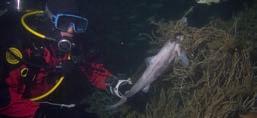
sustainably. Norway has also initiated the program “Fishing for Litter”. e program was established as a national test scheme in 20162017, with twenty vessels and three participating harbours. en in 2020, the program operated with 101 vessels, 11 ports and managed to remove 208 tonnes of waste, of which 55 tonnes was delivered for recycling via No r2.

Norway signed the agreement on global plastics in Nairobi in March 2022, with speci c legally binding provisions and obligations to prevent and remediate plastic pollution and its toxic impacts. is was a major leap towards a plastic free ocean for all, as the resolution addresses the full lifecycle of plastic, including production, design and disposal as well. Currently, the framework is endorsed by 175 countries of the UN and the work is negotiated throughout a series of meetings across the globe and is expected to be in place by the end of 2024.
Even though the international, national and regional legislative instruments implemented by Norway clearly aim to prohibit the discharge of wastes, setting inspection regimes and imposing sanctions, a number of gaps, uncertainties and overlaps with other legislative mechanisms hamper the e ciency of such instruments. Sometimes weak inspection and implementation of the relevant regulations contributes to limited success. Obstacles include availability and use of port reception facilities for ship-generated waste, obligations for waste management, and the reporting and enforcement regimes. Insu cient data
availability on the status of marine litter in the oceans, as well as the current knowledge on the quantities, degradation, and data on the impacts of marine litter are scarce. It is estimated by the European Union that around 20 of shing gear used every year is lost, i.e. around 11,000 tonnes per year. On a global scale, it is believed that nearly 2 of all shing gear, comprising 2,963 km2 of gillnets, 75,049 km2 of purse seine nets, 218 km2 of trawl nets, 739,583 km of longline mainlines, and more than 25 million pots and traps are lost to the ocean annually. To increase data certainty, it is recommended to map the distribution and composition of litter on a yearly basis and collaborate with the oil industry to increase data on marine litter on the sea oor. Data on the amount of retrieved shing gear and recycled/reused ones as compared to the amount of lost gear is very scarce and fragmented, and not comparable with reports on lost gears due to the use of different units of measure.
Recycling and reuse of shing gear is a relatively new focus area in the plastics recycling/reuse industry. Nets used as input are collected either from “ shing for litter” campaigns, or from nets properly deposited at port receptacles. In Norway, nets are collected through by No r, and are then sent to Lithuania for dismantling and nally, depending on the material type, are directed to facilities in the EU and Asia for recycling. Even though the system is ongoing, there are still many challenges. Some of these are the collection and amount of available shing gear (transporters and further users require information on the available amounts and “quality status” of collected gear within a speci c period to plan and organize activities), lack of a
centralized information collection from ports, and a high demand of costly human labour at cleaning and selecting various gear materials. Moreover, the cost of energy and resources necessary to recycle shnets and other marine equipment may be more than the nancial bene t of recycling, while transportation between di erent sites of the value chain only adds to the costs. On the other hand, relying on cheap labour partnerships can in uence long-term sustainability. For example, long transport routes can unexpectedly be blocked due to a pandemic or an increase in fuel prices; partners suddenly increase their charges; or there could be a change in the political situation to the detriment of the partnership. e need for more training and education on problems related to losses of shing gear is also an issue that needs further action and improvement. us, even though recycling/reuse is a priority, there are still many
technical, economical, and infrastructural barriers that must be overcome to improve success and increase awareness and participation.
Despite all the di culties and challenges, and the need for further improvement, Norway is one of the most successful countries when the management of abandoned and end-of-life shing gear is considered. Sharing knowledge of successful approaches as well as working together towards more sustainable sheries would be bene cial for all countries, as the problem is shared. United e orts would lead to more inclusive and permanent solutions with smaller investment of time, budget and energy from individual regions and countries.
Eva Kovacs, eva.kovacs @euro sh.dk, Christian P. Unmack, christian.unmack @euro sh.dk, Euro shThrough a series of 12 short films, children of all ages can learn about the biological, historical, social, economic, and wartime sides of the Baltic Sea.
Many people have heard about the annual “Marriage of the Sea” (Sposalizio del Mare) ceremony in Venice, a ritual throwing of a golden ring into the Adriatic Sea performed by the doge, or spiritual leader, of Venice which symbolises the maritime dominion of Venice. But fewer people know that a similar ceremony also exists in the northern part of Europe. It is called Poland’s “Wedding to the Sea” (Zaślubiny Polski z morzem), and was held for the rst time on 10 February 1920, in the Baltic harbour of Puck, when General Józef Haller threw a ring into a hole made by local shermen in the ice. e event marked Poland’s restored access to the Baltic Sea, the country’s maritime doorway to the world outside.

is fascinating nugget of information opens the Sea in Culture, one of a series of 12 short lms produced by the Baltic Scientist project to spread knowledge about the Baltic Sea to Polish children of all ages. Baltic Scientist is a one-year project of the Gdynia Aquarium, part of the Sea Fisheries Institute/National Marine Fisheries Research Institute (MIR). It is co- nanced from the “Social Responsibility of Science” programme of the Ministry of Education and Science, with support from the European Marine Science Educators Association (EMSEA) and the Foundation for the Development of
Gdynia Aquarium (FRAG). As part of the project, 12 lms are being created, in which scientists and people connected to the eld of oceanography are invited to talk about issues related to the Baltic Sea, their work, their research, and the devices they use to carry them out. e lm crew also visits a research vessel sailing in the waters of the Baltic Sea. Filming and broadcasting began in April 2022 and continue to March 2023.
e dozen lms cover many aspects of Poland’s marine resources, including sh, sustainability, seaweed, the Baltic Coast and climate change, microplastics and biofuels. e project team sought to create captivating stories in which animals become heroes worthy of Hollywood. us, the pike, Esox Lucius, inhabiting the
Bay of Puck becomes a movie star in children’s eyes. A magical aura seems to surround research laboratories, such as in the one devoted to the safety of food of marine origin. Scienti c terms sound like ancient incantations. e idiom zdrów jak ryba (healthy as a sh) is not an empty slogan, as scientists and lm stars discuss the size of the population and the balance of the ecosystem.
On the bottom of the Baltic Sea are reminders from the second world war. About 40,000 tonnes of weapons were discarded in the Baltic by the Allies after World War II, a decision made during the Potsdam Conference. From one of the lms, students learn
that the south-western parts of the Gotland Deep and the Bornholm Deep were designated as the storage places for the arsenal, chosen because they are deep basins far from shore, with little risk of weapons being washed up on the beach.
Most of the movies were lmed in Gdynia, on the Bay of Puck. From its very beginning, Gdynia was designed as a gateway to the sea and has seen dramatic expansion since the second World War. Episodes can be freely viewed on social media, on the website of the Gdynia Aquarium https:// akwarium.gdynia.pl/en/category/ projects/, as well as on the Polish website of Ocean Literacy https:// oceanliteracy.pl/home/.

Eurofish is a member of a consortium that has won a project that will develop, among other outputs, ways to guarantee seafood product safety, quality, and traceability. The purpose is to counter a certain scepticism among some consumers about fresh and farmed seafood.
FishEUTrust, as the project is known, will establish ve Co-creation Living Labs in the Mediterranean Basin, the North Sea and the Atlantic Sea. ese will enable innovation and process validation and demonstrate the project’s supply chain solutions. Examples of supply-chain innovation include creating sustainable business models, protecting cultural and culinary heritage, short food supply chains, exploiting underused sh species, and innovative engagement activities to stimulate positive consumer behaviour. e project will also develop tools to maximize trust by guaranteeing the quality, safety, and traceability of seafood products based on smart control systems (sensors), metagenomics, genetic biomarkers, isotopic techniques, and labelling/product passport/ blockchain). ese tools will be integrated into a single digital FishEUTrust data platform. e project started in June 2022 and will end May 2026. e project involves 22 partners from 14 EU countries, and is coordinated by
Institut Jozef Stefan, Slovenia. As leader of Work Package 3, Euro sh’s role is to develop novel business models to increase trust and e ciency in the seafood supply chains. More information about the project can be found at: https:// sheutrust.org/
Within the same call, the European Commission also awarded a “sister project”, SEA2SEE. is project will use modern technology to reassure consumers about the sustainability of the seafood they eat. Current seafood traceability tools and services have the potential to take advantage of novel blockchain technologies to obtain a wide range of data making sustainable seafood practices more visible to consumers. e SEA2SEE project will ll in existing seafood traceability gaps through development and demonstration of an innovative end-to-end blockchain traceability model throughout the seafood value chain and professional and consumer applications. is to increase trust and social acceptance of sustainably
Partners in the FishEUTrust project will develop tools to guarantee the quality, safety, and traceability of seafood.

shed and farmed seafood. e project will provide technological solutions to answer the need of a valuable source of data collected throughout the whole seafood value chain, veri ed, and covering inputs from diverse stakeholders. For that purpose, a speci c focus will be put on active commitment of stakeholders and real empowerment of consumers through the implementation of societal and sectoral strategies for co-creation, communication and awareness raising. e SEA2SEE
project started in July 2022 and will end June 2026. e project involves 14 partners from six EU countries, and is coordinated by Smartwater Planet SL, Spain. More information about the project can be found at: http://www. sea2see.eu/
For more information regarding the FishEUTrust project, contact: Prof. Dr. Nives Ogrinc Jožef Stefan Institute, Ljubljana Slovenia. +386 1 588 53 87 info- sheutrust@ijs.si
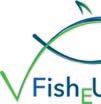
For more information regarding Sea2See project, contact: Dr. Carlos Mazorra de Quero Director of Innovation and R&D Smartwater Planet, S.L. Madrid Spain +34 618810499 contact@sea2see.eu


Many types of fish and seafood are relatively costly foods. This represents a temptation for unscrupulous food fraudsters. They swap expensive species for cheaper ones, manipulate weights or twiddle fillet colouring to simulate freshness. The products offered are not always actually worth their price. In some sushi bars and in restaurants and retail, consumers are deliberately, and sometimes also unknowingly deceived.

Food fraud is a worldwide problem and a lucrative business. Adulterated wine, fake olive oil, oregano bulked out with rock rose leaves, cheap vanillin instead of expensive Bourbon vanilla, conventional products sold as organic goods. ere are plenty of opportunities for fraud. Although no consumer wishes to be taken for a ride, far from all of the expensive things they buy is really what ends up on their plate. Fish and sh products are no exception. e potential for fraud is actually particularly great for them, because who among us is reliably familiar with the variety of species on o er, and is able to detect and correctly determine deception? e risk of being caught cheating is correspondingly low, all the more so as sh are one of the most widely traded goods worldwide. Global markets, complex
supply chains and opaque trading routes create the ideal conditions for cheating and deception. ese extend from lack of information, to communication errors, right up to serious calculated fraud. With almost two thousand sh and seafood species being regularly traded internationally, the range of opportunities for fraud is huge. Particularly because many species look similar and sh are increasingly being sold as llets rather than whole sh. is creates great opportunities to palm o tilapia as red snapper, pangasius as sole or oil sh as genuine butter sh on unsuspecting consumers. e widespread bad practice of selling thawed frozen goods as “fresh” (at best with the cryptic description “refreshed”) is almost a tri e.
In reality faking and deception occur almost everywhere
worldwide, but especially where sh are o ered for sale in processed form, such as in preserved products, frozen food or when prepared in restaurants. e chances of falling victim to a product scam are obviously particularly high in sushi restaurants. Investigations using DNA tests in New York showed that a quarter of sh on the menu did not correspond to the species promised. Two out of four restaurants and six out of ten shmongers sold sh under false names. Seven out of nine maki and nigiri contained signi cantly cheaper species from the Atlantic instead of red snapper. Apparently this sh species is particularly popular for fake products, as tourists in Asian countries are served the red hybrid form of the two tilapia species Oreochromis niloticus and
O. mossambicus as red snapper in every second restaurant. Barramundi (Lates calcarifer) being sold as white snapper on the menu is almost as common.
Disguising the origin of sh products is an even more widespread practice. Disdained farmed species often become sought-after wild sh, which would perhaps still be excusable, although there are certain di erences in the nutritional value. Some of these verbal tricks could be quickly identi ed by consumers if they were better informed. Anyone who, for example, is o ered white sh from Lake Constance in southern Germany should be thoroughly suspicious, because the entire annual catch of this sought-after sh declined to only 20 tonnes in 2022. is would hardly be enough to supply
 The variety of species on local markets and in the international seafood trade is overwhelmingly large, which does not make distinguishing between species easy.
The variety of species on local markets and in the international seafood trade is overwhelmingly large, which does not make distinguishing between species easy.
all catering establishments with regional goods. e situation on the Baltic coast of Germany is exactly the same. Anyone ordering a halibut or red sh there should be aware that these species of sh do not live in the Baltic and that they are therefore probably not receiving fresh sh. Incorrect product labels can, however, result from poor translations. e term ‘lobster’ in English is used for two distinct species, lobster and cray sh.
Incorrect information about sh products is not always intentional and driven by the prospect of nancial gain, it can also be the consequence of a confusing variety of names or di erent legal rules in individual countries. What is right and allowed in one country may be attempted fraud in another. A good example of this is the Patagonian tooth sh (Dissostichus eleginoides), which is marketed in the US as Chilean sea bass. In Argentina and Uruguay it is called merluza negra and in Chile even bacalao. In Japan it is called mero, in France légine australe, in Portugal marlonganegra, in Sweden tandnoting and in Germany Schwarzer Seehecht (black hake) or Schwarzer
Zahn sch (black tooth sh). is confuses not only consumers, but sometimes also importers and retailers, whose ignorance can then lead to incorrect labelling and thereby unintended commercial fraud.

Not every error is therefore a conscious attempt to mislead in order to rip o the consumer and increase pro ts. However, things are completely di erent for what is probably the worst form of sh fraud, the “laundering” of illegal catches from IUU shing. Here fraudsters are particularly inventive and devote signi cant criminal energy, extending from unloading illegal sh onto licensed shing vessels or mixing them with regular catches to fraudulent declarations on the product labels. Concealing the origin alone is fraud. But what is tolerable and where does food fraud begin? e EU Commission has formulated several criteria that suggest justi ed suspicion: “Food criminality is present with intentional or impermissible swaps or additives, falsi cation or incorrect representation of food, food components or packaging or with deceptive statements about a product with the intention of thereby making a nancial gain”. e global food organisation FAO has de ned it in an even clearer
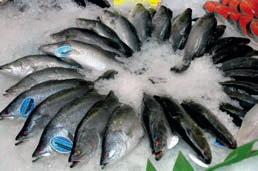
and more understandable way. According to their de nition, fraud can be assumed if
• sh are replaced with other, cheaper species
• goods are incorrectly labelled to disguise their origin
• fake products are sold
• illegal or undeclared additives are used


• water is used to increase the weight.
Regardless of this, tricks, scamming and faking continue to be practised to gain market advantage and increased pro ts. A review of the trade names on labels in the USA showed that only 85 percent were correctly labelled. Often, net weights are
short-weighted or are incorrect, sometimes due to overglazing, but sometimes also through the addition of phosphate to bind water. Some manufacturers increase the amount of coatings and toppings to use less sh for the same packaging weight. Occasionally the country of origin given is also incorrect, to circumvent regulations, customs and fees or to smuggle illegally caught sh into supply chains. Restaurants are very often hotspots for scamming. Mistrust and questions are always recommended if expensive raw goods such as sole, scallops or snapper are on the menu for unusually low prices. If relatively inexpensive prawns are served instead of the more prized and expensive scampi, this has now become a trivial o ence that hardly bothers anybody.
A look at China shows the bizarre side-e ects that trade in fake seafood products causes. ere, Chinese mitten crab (Eriocheir sinensis) is a popular and expensive food, the demand for which far exceeds the supply. Its price depends on the size and origin of the animals. Crabs from
 The red hybrid form of the two tilapia species Oreochromis niloticus and O. mossambicus is often advertised as red snapper on the menu in Asian restaurants.
The red hybrid form of the two tilapia species Oreochromis niloticus and O. mossambicus is often advertised as red snapper on the menu in Asian restaurants.
Not every red-coloured fish is actually a red snapper. In many countries, only the species Lutjanus malabaricus may be sold under this name.
Yangcheng Lake (Jiangsu province), some 30 km west of Shanghai, which are particularly prized for their taste, are the most expensive. Although the Yangcheng produces barely more than 1,000 to 1,500 tonnes of Chinese mitten crab per year, at least 100,000 tonnes a year are sold across the country as “genuine Yangcheng”. In order to protect their valuable goods from cheap substitutes, the local shers and dealers now identify the crabs with a sophisticated marking. ey burn an invisible mark into the shells of the living crabs using lasers which can only be detected when they are cooked. eir e orts were in vain, however, as fraudsters managed to imitate the mark within a short time. e method of dumping the Chinese mitten crabs into the Yangcheng for a few days, thus gaining the right to use the brand
name in a somewhat “legal” way is also popular.
Even more curious is a case in Cleveland (USA) that shows that attempts at fraud are not just restricted to edible sh. ere in October 2022, the apparently wholesome world of competitive angling was shattered, as the jury detected numerous small lead balls in the sh of the supposed winner during weighing. e culprit had intentionally made his catches heavier by doing this, in order to get his hands on the generous 30,000 dollars of prize money. Manufacturers of crab balls in Singapore were just as brazen, as during an o cial review it emerged that 38.5 of products reviewed contained no crab at all, but pork instead. e extent of such large and small frauds is really alarming. e Guardian evaluated the
results of 44 market analyses with 9,000 tests of sh and sh dishes from 30 countries in a metastudy and came to the conclusion that an average of 36 percent of sh and seafood is wrongly declared. Every third sh is therefore not the promised species. ere are di erences between the countries recorded, but trickery and deception happen everywhere. In Italy, an average of 22.5 of shing industry products were wrongly identi ed, in Canada, on the other hand, this was every second product.


In an analysis of 1,000 tests that were carried out on imported sh deliveries at Frankfurt Airport, similar results were shown – over 30 were wrongly declared. And once again, the red snapper was particularly susceptible, which perhaps can be attributed to the fact that at least 38 di erent species of sh are traded under this name in the tropics. Individual species are simply not distinguished from each other accurately enough. ings that are not working in the countries of origin do not look much better in the target markets. An inspection in 2018 showed that in Great Britain, almost 70 of sh sold as red snapper were completely
di erent sh species. ese included many reef species, which, to make matters worse, are also threatened by habitat destruction and over shing. In the supermarkets and restaurants of the USA, Singapore, Australia and New Zealand, 40 of sh tested were not red snapper. ere is method in the madness, since it is not only red snapper, but also other species that are often wrongly labelled. Reviews of sh and seafood ranges in retail and in catering revealed that Canada had the most incorrectly labelled species, at 55, followed by the USA with 38. In Finland and Germany the results were hardly any better. However, it was even more surprising that Spain and Iceland came o relatively badly, since one would really expect more product knowledge from these sh-aware, seafood nations.
Knowledge of sh is helpful, of course, but what else can be done to make business more di cult for fraudsters and scammers? All the more so as the ongoing
Anyone ordering scampi (Nephrops norvegicus) in a restaurant nowadays usually receives simple prawns, which may taste good, but are a completely different species of crustacean.trend towards trading in llets and processed products certainly does not make the unambiguous identi cation of species any easier. e inspectors and analysing laboratories are upgrading and investing in new analysis techniques. In the last two decades, molecular genetic tools have been developed that make it possible to identify sh species from their DNA. Only tiny samples of tissue are required for this, just as we have come to expect from almost every crime series these days. e methods are reliable, but comprehensive market inspections are nevertheless unlikely, because such inspections are relatively expensive and take up signi cant time and sta resources. Also, a reference library with DNA sequences for comparison is required for species identi cation and creating such databases requires sufcient material and takes time. Experts are therefore justi ed
in stating that, given the diversity of sh and seafood species, it would be unrealistic to expect comprehensive monitoring of the relevant market. Which is what would really be needed to protect consumers from product fakery. In fact, currently only two percent of all imported sh deliveries into the USA are checked by the FDA.
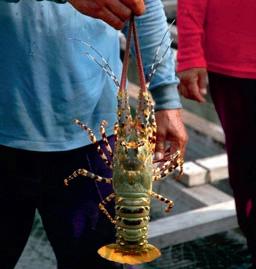
So the contradiction remains for the time being – on the one hand, there is a sensitive and selective range of instruments available for uncovering product fraud and deception, but on the other hand, for a variety of reasons, it is still not possible to monitor the entire market comprehensively. Nevertheless, work is being done worldwide to improve the tricky situation step by step. For example, with the help of the international research campaign FISH-BOL, which catalogues the DNA of sh
species worldwide and makes the nucleotide sequences publicly available. When the FISH-BOL database is eventually complete, it may make the molecular identi cation of global ichthyofauna not only signi cantly simpler and more precise, but also faster and more cost-e ective. Together with other future-oriented analytical tools such as NMR spectroscopy (NMR stands for nuclear magnetic resonance) and stable isotope analysis, even the quality, origin and authenticity of food and whether it contains banned substances or substances not typical of the product can be reliably analysed. Because these devices also allow for the type of cultivation to be checked, fraudsters selling conventional products as organic face signi cantly tougher times ahead.
It would, of course, be even better and more e ective if the food inspectors had easy-to-use rapid tests in order to check the authenticity of the DNA of grouper, snapper, etc. at the import border or directly at the airport in cases of doubt. A small, handy device, for example, into which the user inserts a small sample of tissue and which then gives the name of the sh and further information on the condition of the product after a short time. Although a lot appears to be technically possible, it will probably still be some time until such aids are actually available. Checks of 14 restaurants in the six German cities of Berlin, Leipzig, Erfurt, Frankfurt am Main, Cologne, and Hamburg showed how well DNA analyses are suited to checking sh species. e undercover inspectors ordered sole dishes everywhere
and took small samples of the sh on their plates. Subsequent DNA tests in the lab showed that sole was only actually served in six restaurants. Zander was served twice and the cheaper sh pangasius was served six times. e penalties imposed on the responsible catering establishment were suitably high.
is may have a deterrent e ect in the short term, but does little to address the general problem. If the sinister machinations of a criminal minority are to be exposed, we cannot rely solely on patchy state inspections. More engagement is required from the many genuine players in the sh industry. If everyone conscientiously checked their suppliers and customers themselves, we would be a good way further along the road. e guiding principles must be to never accept raw goods from dubious sources, to conscientiously check the species names of the sh and to correctly provide product weight information. In the USA, the National Fisheries Institute even founded a Better Seafood Board in 2007 to combat fraud in sh and seafood. e Board’s self-monitoring mechanism makes it possible for its members – primarily restaurants, retail operations, sh processors and importers – to report persons and operations suspected of fraud. Sysco, a US food supplier, claims that it acts according to the “one strike and you’re out” principle. Contracts with sh suppliers are ended immediately if they sell wrongly declared sh. ose for whom that is a step too far should at least take note of the MSC, Friend of the Sea or ASC certicates when purchasing. ese do not provide absolute certainty, but they guarantee a minimum level of checks.
Manfred KlinkhardtAlltech and Finnforel announce the acquisition of a fish feed production facility that will complete the circular-economy fish-farming chain.
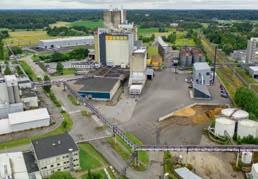
Alltech, a global leader in agriculture and animal nutrition, and Finnforel, a Finnish circular-economy company that farms rainbow trout in recirculation aquaculture systems, are joining forces to acquire the Raisioaqua sh feed production facility from Finnish company Raisio. Raisioaqua manufactures environmentally friendly feed for aquaculture and specialises in functional feeding solutions that are suitable for northern European conditions. e acquisition will complete Finnforel’s sh-farming chain while also enhancing the aquaculture producer’s access to Alltech’s nutritional technologies.
Aquaculture continues to be one of the world’s fastest-growing sources of protein, according to Alltech’s annual Agri-Food Outlook, and is one of the key focus areas for our business, said Dr Mark Lyons, president and CEO of Alltech. Together with Finnforel, we will enhance the quality and availability of nutrition for sustainable aquaculture systems. Aqua producers will bene t from the strength of Alltech’s scienti c research and commercial expertise globally, including a dedicated aqua nutrition research centre, the Alltech
Coppens Aqua Centre (ACAC) in the Netherlands, which specialises in nutrition for recirculating aquaculture systems (RAS).
Alltech continues its commitment to "Working Together for a Planet of Plenty™ by partnering with companies like Finnforel to deliver smarter, more sustainable solutions for aquaculture, resulting in better nutrition and a decreased environmental impact. Backed by over 40 years of researchand customer success, Alltech’s specialty feed ingredients and Alltech Coppensaquafeeds o er superior nutritional solutions for sh and shrimp. e ACAC in the Netherlands is one of Alltech’s ve bioscience centres around the world.
Finnforel and Alltech Coppens have been working together for several years on sustainable aquaculture practices, said Ronald Faber, CEO of Alltech Coppens. is joint acquisition re ects the ambition of both companies, our shared values and the strength of our partnership.
Finnforel specialises in RAS, which allow producers to control water purity, temperature, stocking density and feeding while requiring 99 less water than traditional sh farming methods. e indoor growing tanks provide a less stressful
environment that can be better controlled by aquaculture producers. I believe that Finnforel’s well-honed model, which works without antibiotics or environmental emissions, can support a signi cant part of the market for farmed trout, said Pekka Viljakainen, chairman of the board of Finnforel Oy.
Aquaculture is an e cient way to produce nutritious protein for a growing population. As sustainable recirculating aquaculture systems are viable even in desert conditions, Finnforel’s aim is to export Finnish aquacultural expertise to the world in the coming years. Alltech’s and Finnforel’s acquisition of the Raisioaqua feed production facility will complete the circular-economy sh-farming chain in Finland and provide a replicable model for others.
At the heart of Finnforel’s strategy are so-called gigafactories specialised in sustainable aquaculture, said Mr Viljakainen. In these aquaculture gigafactories, the entire production chain is in our own hands, from the parent sh and the eggs they produce to the consumer products. Feeds developed in accordance with the principles of a sustainable circular economy represents the last link in the chain, added Jussi Mekkonen, CEO of Finnforel Oy. We have another new aquaculture facility that will be completed in spring 2023, after which we will be able to produce the eggs used in sh farming. en, the entire sh-farming chain will be ready to be exported to the world.
For more information, visit nnforel.com, alltech.com, and alltechcoppens.com.
A Belgian company based in Ghent, Cretel combines high quality with affordability in its range of machines.

For over 50 years Cretel has been a trusted supplier of food processing equipment and washing and drying solutions. e highly sophisticated CO2-neutral production facility in the Port of Ghent guarantees Belgian quality throughout the entire line of products. But it is the dedication to top-notch service that truly sets Cretel apart.
A subsidiary of the ATS Group, Cretel produces high quality equipment for the food, pharmaceutical and agroindustries including cutting machines for sh, meat, and poultry, and industrial washing and drying equipment for crates,
containers, and moulds. e company’s food processing equipment o ers both automatic and manual machines, including skinners, sh scalers, pinbone removers and vacuum packers. e washing and drying installations include solutions for crates, pallets, bins, containers, and racks & trolleys. Decades of expertise and experience has resulted in products of the highest quality, tailored to customer needs.
With its 40 employees the company is dedicated to continuous
improvements in not only the design, but also the service of its products. This is realised by being flexible and listening closely to the customer’s requirements. As part of the ATS Group, Cretel benefits from crossover collaborations for large turnkey projects. Tailormade, fully automated solutions are among the options the company offers. Furthermore, an extensive library of original spare parts and replacement machines guarantees excellent service in case of any malfunctions. This further improves the impressive lifespan of Cretel equipment.
Cretel’s experts are always eager to meet with professionals in the industry. From 25 to 27 April, Cretel will be present at the 2023 edition of Seafood Processing Global. Visit Booth 3BB601 to learn more about Cretel’s wide range of products and services. In addition, Cretel will be showcasing demo products, making informative presentations, and displaying brand-new 3D-printed models.
For more information, contact Cretel Tel.: +32 9 376 95 95 info@cretel.com www.cretel.com
Professional glass jar from FIAP for incubation of fish eggs
Acomplete supplier of equipment for the aquaculture industry, FIAP now o ers a glass jar speci cally shaped for incubation of sh eggs that imitates the conditions under which the eggs are incubated in the wild, where they are subject to a steady ow of water. Unlike in nature, eggs in a hatchery can incubate under ideal conditions with minimal uctuations in factors like temperature, rate of ow, and light intensity. As the developing embryo and newly hatched larva are the most delicate stages in the sh life cycle, care is needed to provide optimal conditions.
FIAP’s pro breed EggJar PRO is a real glass incubation jar that
provides natural stream conditions for the optimal incubation of sh eggs and a high hatching rate. e hatching water is led from top to bottom through the inlet pipelocated in the center, which is open on both sides. e large diameter (30 mm) water inlet and a semicircular shaped bottom allow excellent ow conditions. e water requirement is approx. 4–5 liters per minute.
e egg jar comes with a 1,000 micron lid strainer that prevents egg loss. When the eggs hatch, the lid strainer is removed to allow the sh to swim. e probreed EggJar PRO is suitable for trout, salmon, rock bass, cat sh, tilapia and many other sh species and has a capacity of approx. 45,000 trout eggs.
The profibreed EggJar PRO incubation jar from FIAP gives eggs the conditions they need at this highly delicate stage of the fish life cycle.

For more information, contact:
FIAP GmbH
Jakob - Oswald - Strasse 16
D-92289 Ursensollen Germany
info@ ap.de
www. ap.de
Customer Service Phone: +49 (0) 96 28 92 13 0
Fish is a valuable product. It is diverse and challenging in the variety of thermal processes used to treat it. Homogeneous and efficient drying and thermal treatment is essential for perfect product quality, optimal yield and consistency of the final product. Ideally, the airflow should be parallel to the product, so that the air can flow over it with the least possible resistance, transferring heat and absorbing moisture efficiently.
Typical lying products are sh llets such as cold smoked salmon. Regardless of the speci cations, the manufacturers of these products have the same goal: to achieve high trolley loadings for the most
e cient production possible. With lying salmon llets and a high number of levels (typically 26 on a 2 meter high trolley), there is almost no space left for the air to ow over the products evenly, if the smokehouse
works with vertical air ow. is also applies for vertical air ow systems with alternating air aps to vary the air ow on the two sides of the chamber, as the vertical air ow component still predominates.

erefore, systems with proper air ow technology that treat the products with absolutely horizontal air ow are essential. ese so called horizontal cross- ow systems work according to the principle that air must be owing parallel to the product in order to ensure uniform and optimal treatment of all llets at the same time. Having introduced this technology more than 20 years ago, REICH is today the global leader in the area of thermal food processing systems with horizontal cross- ow.
Numerous references from around the world impressively con rm the company’s expertise in this eld.
Systems in the REICH AIRMASTER® UKQ series cause air to ow absolutely horizontally from one side into the treatment chamber of the system and suction it out again on the opposite side. e direction of air ow changes at variable intervals. As a result, the air ow covers all levels of the trolleys evenly, and there are no areas which are under- or overdried. So the operator can control and adjust the weight loss exactly to his requirements. Losing yield
unnecessarily belongs to the past. When it comes to uniformity and e ectiveness, the AIRMASTER® UKQ AIRJET is considered the benchmark in thermal treatment of lying products. is precision increases pro ts by ensuring maximum yield.
Depending on the product, up to 42 levels per trolley are possible. In comparison to commonly available systems, it is possible to achieve double the loading capacity for many products.
Combined with shorter process times thanks to the outstanding air circulation volume, the system can even achieve signi cantly greater increases in capacity.
e advantages of AIRMASTER® UKQ systems can be studied at the REICH technical centre. If interested, please book an appointment to be inspired by REICH solutions for your product.
For more information, contact:
REICH ermoprozesstechnik GmbH
sales@reich-germany.de www. reich-germany.de
The United States’ Food and Drug Agency (FDA) demands that film packaging for fresh fish has a certain oxygen transmission rate (OTR) to ensure the highest product safety. The film specialist Wentus, from Höxter, Germany has implemented the strict FDA specifications with the film solutions Wentopro SkinTight® 20 UHT and UHT-M. These innovations offer the packaged products maximum safety, as well as present them in a particularly attractive way.
Wentus designs and creates exible packaging solutions for the food and consumer goods industry. e 58-year old company has a long tradition of research and development to continuously improve its products. ese optimisations secure greater product protection but also greater environmental sustainability. e company has an in-house production chain allowing it to rapidly develop customised solutions for a wide range of requirements.
e high-performance skin lms
Wentopro SkinTight® 20 UHT and UHT-M are characterised by special strength and excellent cutting
and sealing properties. With an oxygen permeability of >10,000 cc/ m2/24 hours at 24°C, they meet the high US requirements for packaging fresh sh. e tight- tting skin lms, which are also suitable for direct freezing, prevent drip-loss and x the sh rmly in its packaging. is allows the product to be presented invitingly at the point of sale, even vertically. e unique gloss that characterises all lms in the Wentopro SkinTight® range enhances the look of the product.
e innovative UHT lms improve the taste, colour retention, and smell of the packaged goods.

Less food waste, more resource conservation anks to the optimal microbiological processes taking place
The innovative UHT films improve the taste, colour retention and smell of the packaged goods.
inside the packaging, the skin lms improve the shelf life of the packaged product and thus contribute to reducing food waste.
e high-performance and at the same time particularly thin materials reduce the overall use of plastics and thus enable
a more resource-saving packaging process. In the Wentopro SkinTight® 20 UHT-M variant, the lm is also adapted to seal bottom webs or trays made of mono-PET or -PP, and supports the use of more recyclable packaging components.
EFSA’s work contributes to keeping consumers in the EU healthy
The European Food Safety Authority (EFSA) is an independent scientific agency of the European Union (EU), established in 2002 to provide scientific advice and risk assessment on food safety to protect consumers. Based in Parma, Italy, EFSA is responsible for assessing and communicating risks associated with the food chain, including food and feed production, processing, and distribution. EFSA evaluates data and conducts research to provide advice to the EU institutions and member states on a range of issues, including food additives, contaminants, genetically modified organisms, and nutrition. Its role is critical in ensuring the safety of the food we eat and promoting public health across the EU. EFSA scientist Angelo Maggiore, a member of EFSA’s unit for Knowledge, Innovation and Partnership Management explains the authority’s response to some of the newer challenges it
e impacts of climate change can already be felt on the sheries and aquaculture sector in Europe as waters warm, species migrate from their traditional habitats, weather events become more extreme, and alien species spread. In the realm of food safety what are the kinds of challenges that climate change brings and how can they be addressed?
Climate change poses signi cant challenges to food safety. Longterm changes in temperature, humidity, rainfall patterns and the frequency of extreme weather events can a ect for example the occurrence and intensity of certain food-borne diseases, and favour the establishment of invasive alien species harmful to plant and animal health. is was one of the key ndings of our project on climate change as a driver of emerging risks for food and feed safety, plant, animal health and nutritional quality (CLEFSA), which looked at over 100 emerging risks.
For the sheries and aquaculture sector speci cally, climate change can a ect the occurrence,
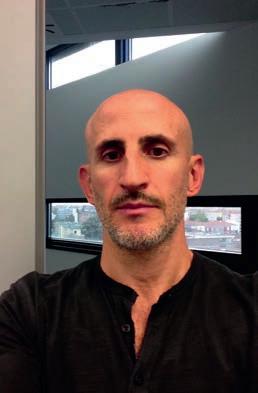
intensity and toxicity of blooms of potentially toxic marine and freshwater algae and bacteria. Marine biotoxins are among the most likely emerging risks to human health that we will face in the future as a result of climate change.
Other e ects of climate change include impacts on toxic compounds such as their transport pathways in the environment, their fate (including bioaccumulation and elimination), their toxicity and our exposure to them. e introduction and spread of new pests and diseases as a result of a changing climate may also a ect the use of veterinary drugs (potentially contributing to antibiotic resistance). Heavier and more frequent rainfall increases the risk of sewer over ow into rivers and coastal environments. In addition, more extreme climatic conditions may a ect food hygiene in primary production, storage, transport and distribution.
We face diverse challenges as a result. First of all, we must take climate change into consideration when carrying out risk
Rising CO2 and climate change will affect the quality and distribution of food, with subsequent effects on food safety and nutrition.

assessments of the food chain. Environmental scanning exercises can boost our preparedness by identifying signals of emerging risks. More generally, applying One Health principles, experts in di erent disciplines (for example, epidemiology, analytical chemistry, marine veterinary, aquaculture, and toxicology) should collaborate more closely by sharing their knowledge and expertise in their di erent elds.
Does climate change introduce new threats to seafood safety, or does it “just” increase the risk levels of existing threats? Do new threats call for the development of new systems to reduce the risk to the public? Please provide a couple of examples of new climatechange-associated threats to seafood.

Climate change can do both. It can increase our exposure or susceptibility to known and new hazards. Our CLEFSA project

identified a series of potential emerging risks related to marine biotoxins, with ciguatoxins identified as the most likely emerging risk to human health.
Ciguatera fish poisoning (CFP) is the most common type of marine biotoxin food poisoning worldwide. It is typically caused by the consumption of fish that have accumulated ciguatoxins (CTX), which are produced by microalgae.
Typical of (sub)tropical areas, CFP was rst recorded in the Spanish and Portuguese Macaronesia islands in 2004. EFSA and the Spanish Agency for Food Safety and Nutrition (AESAN) launched funding for the EuroCigua project a few years ago to better understand the risks of CFP in Europe. e initiative aimed at determining the epidemiological characteristics of CFP, analyse the presence of CTX in microalgae and sh, and develop analytical methods to characterise CTXs. A followup project is ongoing to collect
more data needed to ensure adequate management of risks from CFP.
Cyanobacteria in food is another example. Our scientists looked at our exposure to cyanobacterial populations and their toxicity to help develop predictive models, also considering environmental factors a ecting their dominance, persistence and toxicity. Our results suggests that in a future scenario of global warming, we can expect the exposure of humans and farmed animals to cyanotoxins to increase.
Our CLEFSA project emphasised the need for policymakers and other relevant players in the food system to consider increasing surveillance and monitoring to prepare for emerging risks. Climate change considerations can substantially impact the relevance of risk assessment. In addition, we need holistic approaches to deal with multiple stressors (including climate change) in the food and feed safety area.
Ensuring seafood safety calls for a high level of coordination between EFSA and di erent national and international authorities to ensure action can be rapidly initiated when necessary and the health of consumers safeguarded. Do food safety threats posed by climate change challenge this system of coordination?
Collaboration is one of EFSA’s core values. Climate change is indeed a test case for how scientists can work more closely together. We need more transdisciplinary research and data to be shared among scientists. Closer collaboration is also needed between risk managers, risk assessors and researchers.
To facilitate such exchanges in this area, EFSA has established two knowledge networks, the Emerging risks Exchange Networks (EREN) and the Stakeholder Discussion Group (StaDGER).
e EREN was established in 2010 to promote the exchange of information, expertise and the coordination of activities among Member States and observers. e StaDG-ER, also set up in 2010, enables EFSA to capitalise on stakeholders’ specialist knowledge in this area, and to improve the exchange of information and dialogue on emerging risks.
In the context of the CLEFSA project, EFSA has built up an interdisciplinary network, comprised of experts from international intergovernmental organisations and coordinators of large EU projects involved with climate change.

Marine biotoxins from algal blooms, for example, can a ect sh and shell sh production and can also have an impact on human health. Is climate change changing the lethality or prevalence of marine biotoxins, or introducing new varieties? How does EFSA keep track of these developments?
Climate change impacts such as rises in temperature, longer stratication periods, ooding of estuarine environments and increases in nutrients in coastal environments could create favourable conditions for the growth of a variety of microalgae and bacteria. is would a ect the prevalence of marine biotoxins and could potentially see new varieties introduced. Less is known about the e ect on the toxicity of the blooms as this depends on various factors such as the
relative abundance of the toxic genotype, production of the most toxic variants or the increase in toxin production rate. In order to keep track of new developments, EFSA uses its EREN and StaDGER networks as well as the work of its ten expert Panels.
EFSA has also just launched a foresight study on future challenges for the safety of food and feed coming from our oceans. e objective is to map future uses of the ocean and its resources in the context of global changes, and to identify emerging risks for food and feed safety, and other issues that could be relevant for EFSA. Policy and technological developments related to aquaculture and shing will play a major role in scoping the assessments.
e widespread presence of microplastics in the marine ecosystem means that sh and shell sh are dietary sources of microplastics for humans. What are the health implications for humans of consuming microplastics? What does EFSA recommend with regard to how much seafood people should consume to limit the consumption of microplastics?
EFSA published a statement in 2016 on the presence of microplastics and nanoplastics in food, in particular in seafood. According to the data available in the literature at that time, the average number of particles found in sh was between 1 and 7, in shrimp, an average of 0.75 particles/gram, and in bivalves the average number of particles was 0.2–4 (median value)/gram. Comparisons of microplastic content need to be undertaken with care due to the di erent units reported by the
di erent authors (e.g. number of particles/marine organism or number of particles/g wet weight).
e digestive tract of marine organisms seems to contain the largest quantities of microplastics. Gutting before consumption will decrease the exposure compared to eating whole sh. However, this would not apply to shell sh such as crustaceans, bivalve molluscs and certain species of small sh as in those cases the digestive tract is not removed.
A potential concern is that microplastics can absorb contaminants. e main contaminants for which some information was available related to polychlorinated biphenyls (PCBs) and polycyclic aromatic hydrocarbons (PAHs) that can accumulate in microplastics. ere might also be residues of chemical substances contained in the plastics, such as bisphenol A (BPA) and phthalates. Based on the available studies, only microplastics smaller than 150 µm may cross the gut epithelium and cause systemic exposure. e absorption of these microplastics is expected to be limited (≤ 0.3), and only the smallest fraction (size < 1.5 µm) may penetrate into organs.
In our statement, we made a conservative estimate of our exposure to microplastics after consumption of a portion of mussels (225 g), resulting in a value of 7 µg of plastics. Considering the highest concentrations of contaminants in the plastics reported, and assuming the complete release of the contaminant from the microplastics, that portion of mussels would have a very small e ect on our overall exposure to
PCBs (increase < 0.006) or PAHs (increase < 0.004).
How does EFSA assess sh feed additives?
Our role is to provide scientific advice to support the authorisation process of feed additives. We carry out an evaluation of each new additive submitted for authorisation, of each new use of an authorised feed additive or on the modification or renewal of an authorised additive. Companies wishing to market an additive in the EU must submit an application and a technical dossier with information on the additive, its conditions of use, control methods and data demonstrating its safety and efficacy. Our expert Panel reviews this information and examines the efficacy and safety of the additive in terms of animal and human health as well as the environment. In parallel, the European Union Reference Laboratory for Feed Additives evaluates the analytical methods used to determine the presence of the additive in feed and its possible residues in food.
e European Commission (EC) decides whether or not to authorise feed additives considering EFSA’s scienti c advice as well as other relevant factors, in particular potential bene ts for animal health and welfare and for the consumer of shery/aquaculture products. When an EFSA assessment concludes that the safety of a feed additive has been demonstrated but its e cacy has not, the EC is still in a position to authorise the product but should provide a justi cation for deviating from EFSA’s assessment.
What are the criteria used to measure the welfare of sh and shell sh? How does EFSA contribute to policies that govern the welfare of farmed sh and shell sh?
In 2009, our experts carried out work on a general approach to fish welfare and to the concept of sentience in fish. We recommended that a range of welfare indicators should be considered when animal welfare is being evaluated. Indicators of fish welfare should be species-specific, validated, reliable, feasible, and auditable. The European Commission is currently undertaking a comprehensive evaluation of the EU’s animal welfare legislation and as part of this we are providing new advice that reflects the most up-to-date scientific research and data. We expect a new mandate from the European Commission on this topic in the near future. Any new work we carry out will consider the most recent animal welfare approaches and methodologies, but ultimately the criteria used will depend on the content of any new mandate sent to us.
Animal welfare is an increasingly important part of EFSA’s remit. Our activities in the area of sh welfare are carried out in the wider context of animal health and welfare by our Panel on animal health and welfare (AHAW). e Panel provides independent scienti c advice to risk managers on all aspects of animal diseases and animal welfare. Our scienti c assessments help risk managers identify methods to reduce unnecessary pain, distress and su ering for animals and to improve welfare wherever possible.
18-19 April 2023
Hørkram Spring Exhibition
Copenhagen, Denmark
Tel.: +45 57 87 04 00 sjf@hoka.dk www.hoka.dk
11-13 September 2023
Seafood Expo Asia

Singapore
Tel.: +1 207 842 5590 sales-asia@seafoodexpo.com www.seafoodexpo.com/asia/
10-12 October 2023
DanFish

Aalborg, Denmark
Tel.: +45 99 35 55 18 ehe@akkc.dk www.danfish.com
25-27 April 2023
Seafood Expo Global Barcelona, Spain
Tel.: +1 207 842 5590 sales-global@seafoodexpo.com www.seafoodexpo.com


14-15 September 2023
9th Fish Congress
Sopot, Poland
Tel.: +48 58 620 56 59 kongres@mprfish.com www.kongresrybny.pl
22-24 August 2023
Aqua Nor
Trondheim, Norway
Tel.: +47 73 56 86 40 post@nor-fishing.no https://aquanor.no/en/
18-21 September 2023
Aquaculture Europe
Vienna, Austria mario@marevent.com www.aquaeas.org
10-12 October 2023
ColdWater Seafood
Amsterdam, Netherlands
Tel.: +47 469 20 337 vidar@coldwaterseafood.eu https://coldwater-seafood.prezly.com/

5-7 September 2023
Global Shrimp Forum
Utrecht, Netherlands
www.shrimp-forum.com
3-5 October 2023
Conxemar
Vigo, Spain Tel.: +34 986 433351 conxemar@conxemar.com https://conxemar.com/es/feria-conxemar-2023
25-27 February 2024
fish international Bremen, Germany
Tel.: + 49 421 3505 260 fishinternational.de info@fishinternational.de
Publisher Euro sh International Organisation
H.C. Andersens Boulevard 44-46
DK-1553 Copenhagen V Denmark
Tel.: +45 333 777 55, info@euro sh.dk euro sh.dk
Managing editor Marco Frederiksen
Editorial offices Behnan Thomas (bt)
H.C. Andersens Boulevard 44-46
DK-1553 Copenhagen V Denmark
Tel.: +45 333 777 64 behnan.thomas@euro sh.dk
Dr. Manfred Klinkhardt (mk) Redaktionsbüro Delbrück Franz-Stock-Straße 23
D-33129 Delbrück Germany
Tel.: +49 5250 933416 manfred.klinkhardt@web.de
Technical layout Thomas Jensen
Advertising AVW Marco Preuss Marderstieg 7a

D-21717 Fredenbeck Germany
Tel.: +49 4149 7570 avw.preuss@gmx.de
Aleksandra Petersen
Euro sh Magazine
H.C. Andersens Boulevard 44-46
DK-1553 Copenhagen V Denmark
Tel.: +45 333 777 63 aleksandra.petersen@euro sh.dk

Frequency 6 issues per year
Subscription
Unless otherwise stated, the copyright for articles in this magazine is vested in the publisher. Articles may not be reproduced without written permission from the copyright holders. A soft copy is available on request to aleksandra.petersen@euro sh.dk
ISSN 1868-5943

Order your free trial info@eurofish.dk

Insulated containers

You Can Count On!
Pioneers in production of insulated plastic containers

Pelagic fish processing
Nobbingmachines andAuto-packers forsardineandmackerel
VredenburgSouthAfrica
Mobile: +27 83 2620362
E-mail: easycancc@gmail.com

Website: www.easycan.co.za

Polystyrene compressors
A/S
The specialist in fishbox compactors and recycling Tel. +45 97371799
runi@runi.dk www.runi.dk
Thermal conditioning
ONE OF THE MAIN MANUFACTURES OF PROCESSING MACHINES FOR BIG, SMALL AND VERY SMALL PELAGIC FISH

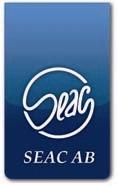
Nobbing down to 110 pcs/kg
Filleting down to 100 pcs/kg
Up to 450 fish pockets per min
Slånbärsv.4, SE-386 90 Öland Sweden
info@seac.se WWW. SEAC.SE
Slicers
A different
kettle of fish
Collect a free copy from the Eurofish stand, 5J600, at Seafood Expo Global in Barcelona 25-27 April 2023

SALMCO Technik GmbH
Robert-Koch-Straße 19
D-22851 Hamburg-Norderstedt
Tel.: +49 40 7131472
Fax: +49 40 71370166
info@salmco.com
www.salmco.com







